RAGBRAI's 50th anniversary inspection ride: The variety of Iowa
DAY 7
5 p.m. Saturday
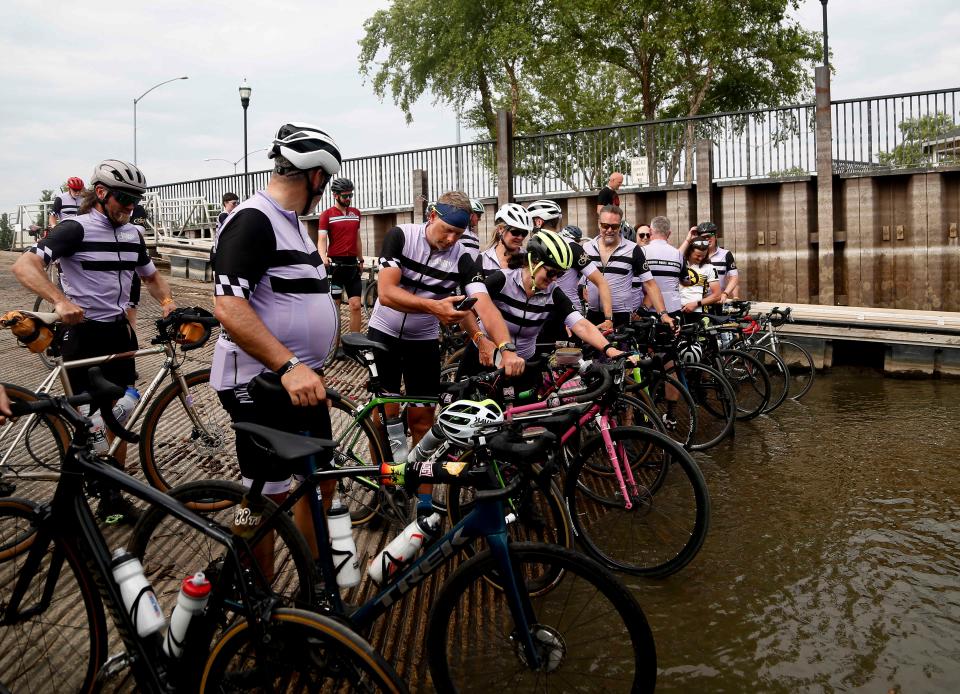
Aside from one mishap ― my own crash when I hit a big crack in the road 4 miles from the tire dip ― RAGBRAI's 2023 route inspection ride ended uneventfully as the riders arrived in Davenport on Saturday.
But that doesn't mean it was a dull ride. Our seven days on the road showed us that the 50th anniversary edition of the Register's Annual Great Bicycle Ride Across Iowa will have more variety of scenery, history and people than perhaps any other in RAGBRAI history, and some of the most memorable stops.
It will begin six weeks from Sunday in Sioux City, Iowa's westernmost metro area, on the Missouri River, where long before it stood, Lewis and Clark journeyed through and left behind the remains of the only member of their crew to die on their epic journey to the Pacific. The grave of Sgt. Charles Floyd, who succumbed to appendicitis, is marked with a sandstone obelisk on a high bluff over the river valley.
As they journeyed up the river, the explorers encountered more than 50 indigenous tribes, including the Sioux for whom the city and its Big Sioux River are named. Siouxland, as the Iowa-Nebraska-South Dakota tristate is known, is still home to members of the Omaha, Winnebago and Ponca tribes.
Sioux City also has one of Iowa's highest proportions of Latino population, rivaling the first overnight town, Storm Lake.
In addition, the ride will overnight in or around Iowa's two largest college towns, Ames, home of Iowa State University, and Coralville, part of the Iowa City metro, which the University of Iowa calls home. Both schools draw students from around the globe. And of course, it will stop in Des Moines, which has been welcoming refugees from places as varied as Laos, Somalia, Bosnia-Herzegovina, Bhutan and most recently, Afghanistan, for almost as long as RAGBRAI has been around.
Even the smallest overnight city on the route, the combined area of Tama and Toledo, with a collective 5,400 people, has a significant indigenous population whose history reflects their determination to remain in Iowa despite the efforts of early white settlers to relocate them to a Kansas reservation.
As a Latino citizen of rural Iowa, Ro Rosario, 53, who is leading an effort by South Tama High School to decorate Tama-Toledo for RAGBRAI, has experienced the sting of not being wanted in certain places because of his heritage. But he said Tama-Toledo is a diverse town that he's confident will wrap its arms around the international crowd.
"It's a warm welcome," Rosario said.
Day 7 pass-through town West Jefferson is another small city with surprising diversity, part of Muscatine County, where people of Hispanic heritage make up almost of fifth of the total population. Charles Brooke, head of the West Jefferson RAGBRAI organizing committee, said the 50th anniversary ride will showcase the varies communities that make up Iowa in a way no previous ride has.
"From Sioux City all the way to Davebnport, we're hitting everything," Brooke said.
Can't wait to see you in July!
― Philip Joens
11:30 a.m. Saturday
Down by the river
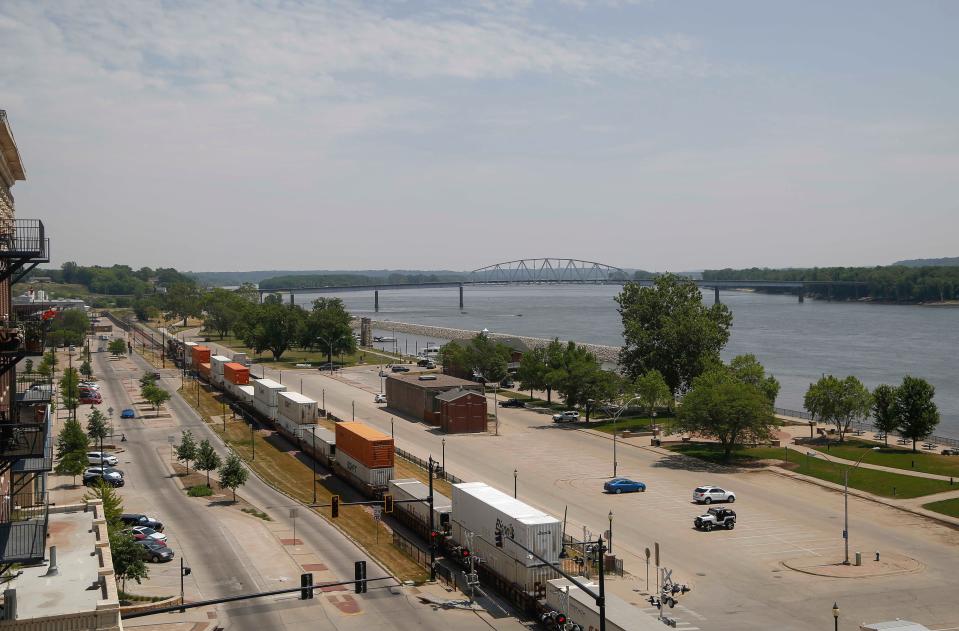
RAGBRAI route inspection riders have reached the Mississippi River at Muscatine. Usually, that means the ride is over, or soon will be. But the 50th anniversary edition of the Register's Annual Great Bicycle Ride Across Iowa will be different.
Muscatine has been the ending town for RAGBRAI six times: 1976, 1986, 1995, 2001, 2006 and 2016. But for the first time it will be a pass-through town on the final day, July 29. Instead, riders will enjoy 27 miles of riverside scenery on their way to end point in Davenport ― which also was the finishing line for the initial ride in 1973.
Ride director Matt Phippen said previously that he wanted riders to experience the ride along the Mississippi from Muscatine through Buffalo, inspired by a similar, though shorter, route along the river into the 2022 ending town of Lansing. Aside from the scenery, it has this going for it: It's flat.
― Philip Joens
9:30 a.m. Saturday
Kinnick takes its turn
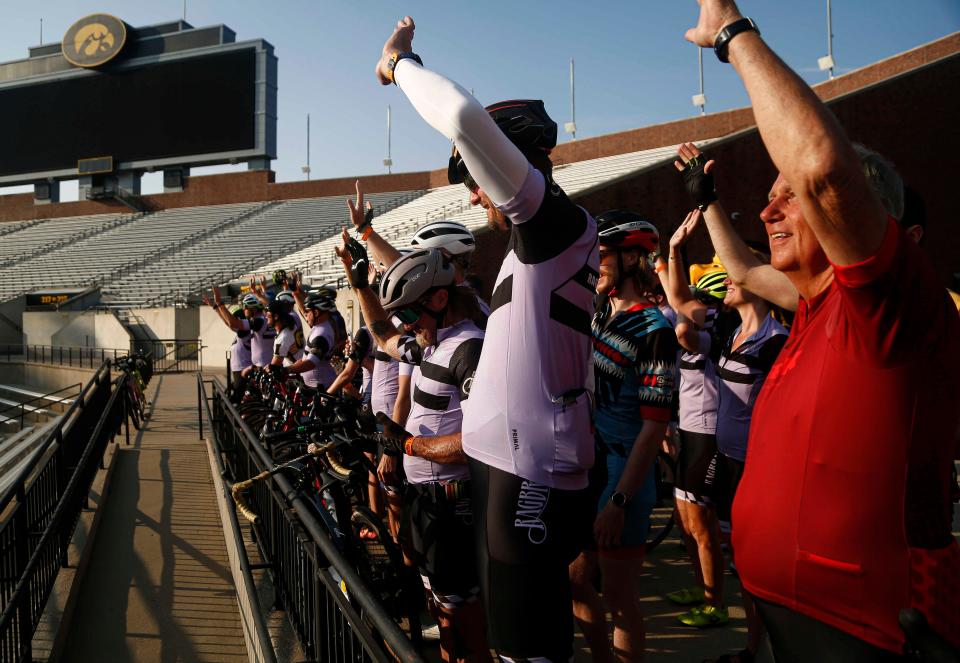
On Day 3 the RAGBRAI route inspection team took a lap around the track inside Jack Trice Stadium as we rode into the overnight town of Ames. It'll be repeated when the Register's Annual Great Bicycle Ride Across Iowa's 50th anniversary edition reaches the home of Iowa State University on July 25, something the ride did for the first time when it visited Ames in 2018.
Anything you do at least twice is a tradition, right?
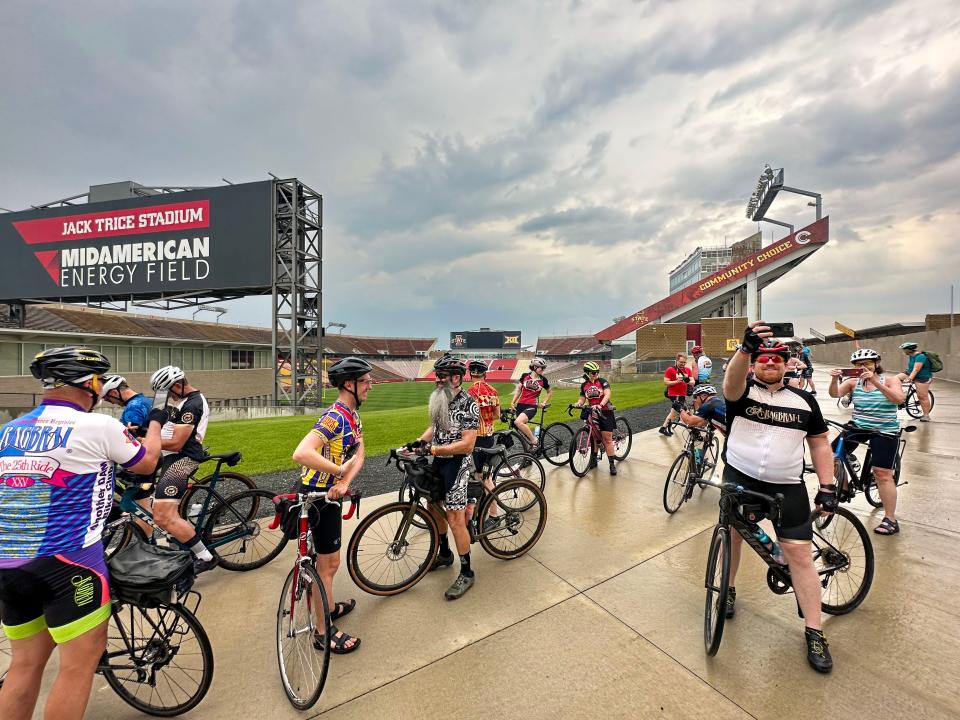
The University of Iowa is determined not to be outdone by its cross-state rival when it comes to rituals, even though there isn't a track inside Kinnick Stadium. So as the ride wound through campus Saturday morning on the way to downtown Iowa City, the concourse gates came open and we passed through the stadium's interior, pausing at an opening for a view of the field below.
"The best view in Iowa," ride director Matt Phippen quipped as the Hawkeyes fight song played over the loudspeakers.
It'll happen again as RAGBRAI comes through on Day 7, July 29, so Hawkeyes be warned: Don't pack away your black and gold after College Jersey Day on July 28.
Joshua Schamberger, president of the Think Iowa City convention and visitors bureau, said he'd been thinking about a Kinnick visit since making the Trice lap with Phippen on the 2018 route inspection ride, when Phippen was a RAGBRAI volunteer and manager of the bike department at the Coralville Scheel's store.
"Matt and I were the first two to ride through (Trice) on the pre-ride," Schamberger recalled. "Matt's working at Scheel's at the time and he's like, "Is there any way you could pull that off?'"
It didn't happen in 2018, even though Iowa City was on the route. But with five years to work on it, Schamberger said the university is ready. It'll be a classic moment on a classic ride.
The riders entered Kinnick on the south concourse next to the Nile Kinnick statue. Then they proceeded to the opening on the southwest corner, where they could get their photos taken with the field in the background, then departed through the west concourse.
On RAGBRAI, "It'll be a little slow in the morning because people will want to take in the experience, but it'll all work out," Schamberger said.
― Philip Joens
6 a.m. Saturday
On the homestretch
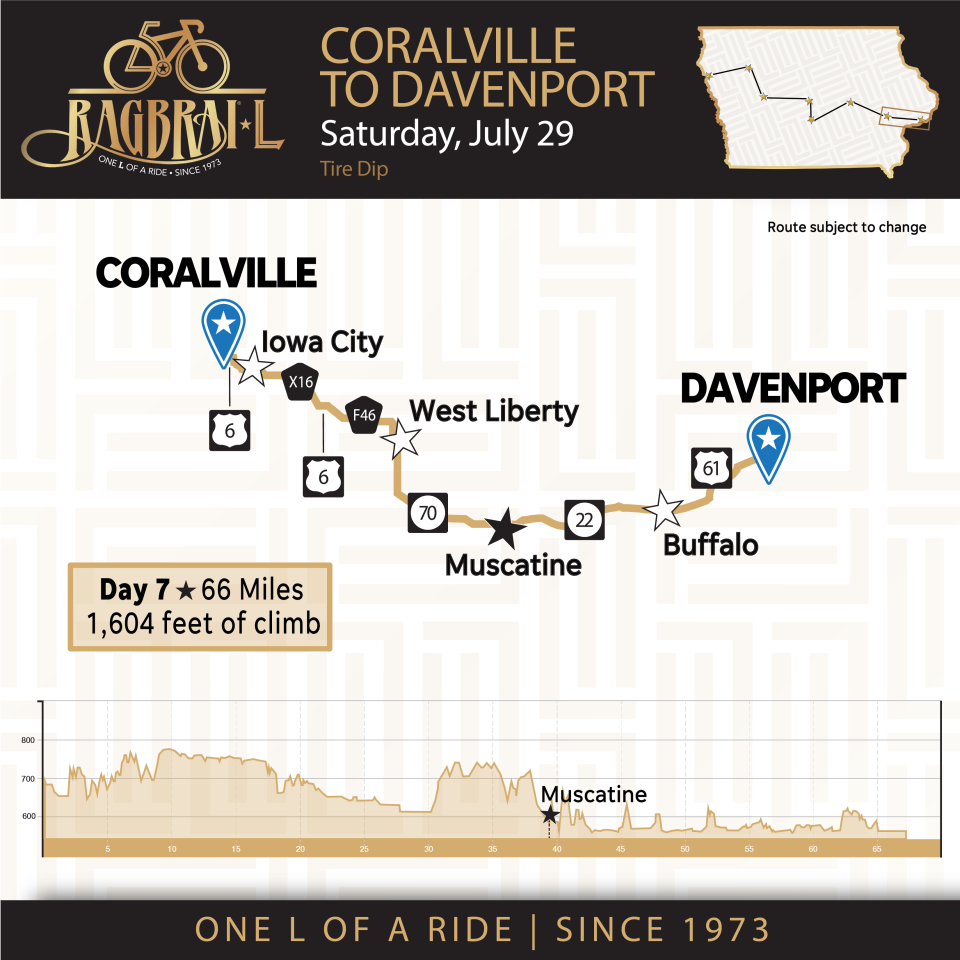
It’s been a good week. But it’s been a long week. So as always at the end of a RAGBRAI ride, we’re all more than ready to dip a tire in the Mississippi, take a bow and head for our own beds. But there’s still one more segment to go, one more set of irreplaceable experiences to be logged into our memories. So off we go from Coralville through the University of Iowa, downtown Iowa City and on to Muscatine and then a blessedly flat riverside ride to Davenport.
Some of us on the inspection ride will be back to in July, when the 50th anniversary Register’s Annual Great Bicycle Ride Across Iowa once again takes us from river to river across this beautiful state. Thanks from coming along!
Today’s route
Coralville to Davenport
Miles: 66
Climb: 1,604 feet
Meeting town: Muscatine
Pass-through towns: Iowa City, West Liberty, Buffalo
What to know: It was only about six weeks ago that the Mississippi was in a historic flood, cresting at nearly 22 feet in the Quad Cities. Parts of today’s route, designed to give riders a nice, long look at the river, were underwater, and so was the tire dip site at Veterans Memorial Park in Davenport. This morning’s river stage is expected to be 6 feet, a reminder of just how changeable the continent’s mightiest river can be. Hope for sufficient rain this summer to keep the corn green, but also just enough to keep the river within its banks.
DAY 6
5 p.m. Friday
Coralville at last
Cyclists on the RAGBRAI 50th anniversary route inspection team ended the sixth day of their test ride across Iowa in Coralville shortly after 5 p.m. at the Coralville Recreational Center, which sits in the northernmost part of RAGBRAI’s planned July 28 campsite, S.T. Morrison Park.
Some local officials, organizations and members of the community were in attendance to welcome the riders into town as they arrived well ahead of schedule. The crew celebrated the completion of another day by drinking chocolate milk and posing for pictures with a surprise guest — Herky the Hawk — who appeared from the rec center as they rolled up. Several had donned their University of Iowa biking jerseys in anticipation of the day's final destination.
Kylee Stock of Think Iowa City was among the welcoming party. She said she has memories of RAGBRAI coming through Cedar Rapids, her hometown, many times when she was younger.
“It’s great that we can welcome such a big event to town,” Stock said.
RAGBRAI will wend its way through the University of Iowa campus and downtown Iowa City on the early morning on its final day, July 29.
“It feels pretty special that they chose Coralville as an overnight town for their 50th anniversary,” Stock added.
Members of the local government were also in attendance to welcome riders. Laurie Goodrich, who is a member of Coralville City Council, was there with her husband Jim, a RAGBRAI veteran.
“It’s very exciting,” Goodrich said. “The team that’s working to bring this to Coralville is working really hard.”
The route inspection riders weren't quite done. Like a lot of riders in July who are expected to take advantage of the Iowa City metro's abundant hotel choices, they left the park for a 2-mile pedal west to their accommodations at the Iowa River Landing, where they will spend their final night on the ride.
They were previously scheduled to visit Backpocket Brewing there to sample the beer the business is brewing in commemoration of the city’s 150th anniversary, which also is this year, but those plans were canceled, Coralville Mayor Meghann Foster told the Press-Citizen earlier Friday.
― Ryan Hansen
3 p.m. Friday
Volunteers needed in Coralville
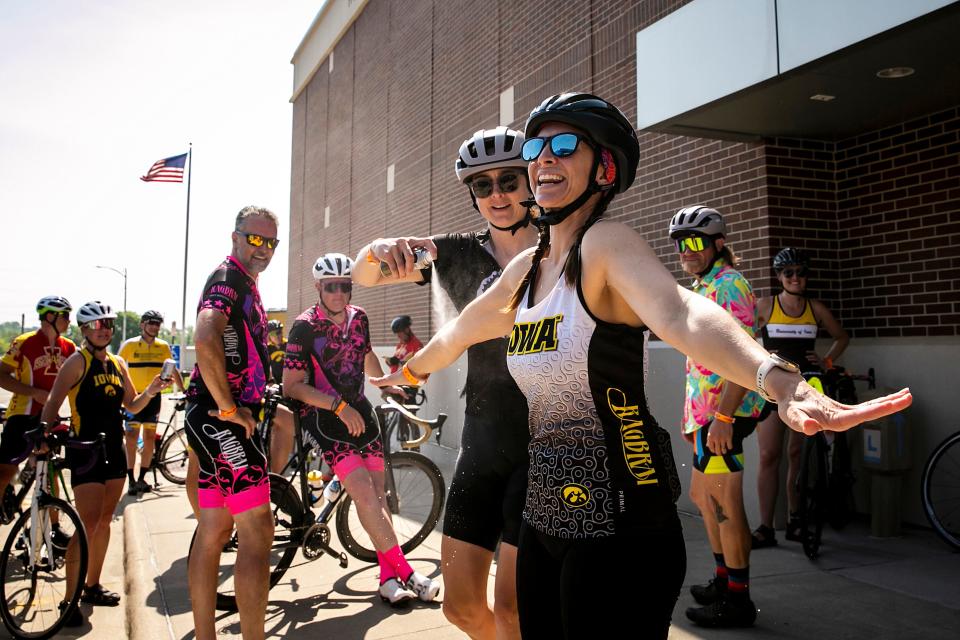
Awaiting the arrival of the RAGBRAI route inspection team, Coralville Mayor Meghann Foster spoke about the excitement of city residents when the ride announced Coralville as an overnight town for the sixth time. It was last selected as an overnight town in 2015.
“The very evening that Coralville was announced as an overnight town, I began receiving emails from the community asking how folks could help, how folks could pitch in,” Foster said. “A lot of these are residents that have lived in our community for long enough to remember ... all the other times RAGBRAI has come through, so they're excited.”
The city is looking for 900 volunteers for the event, Foster said.
S.T. Morrison park, which includes a water park, small baseball field and playground, will be the campground, hosting more than 25,000 riders. Additional open green space is available next to adjacent Northwest Middle and Kirkland Elementary schools.
Even more people are expected to flock to the park to meet family and friends and take in a free performance from the band Bush.
“This truly is an opportunity for us to showcase our community to people from all over the nation and actually across the globe,” Foster said. “We know that there are people that come from other countries to participate in RAGBRAI and we are really proud of our community and everything that we have to offer.”
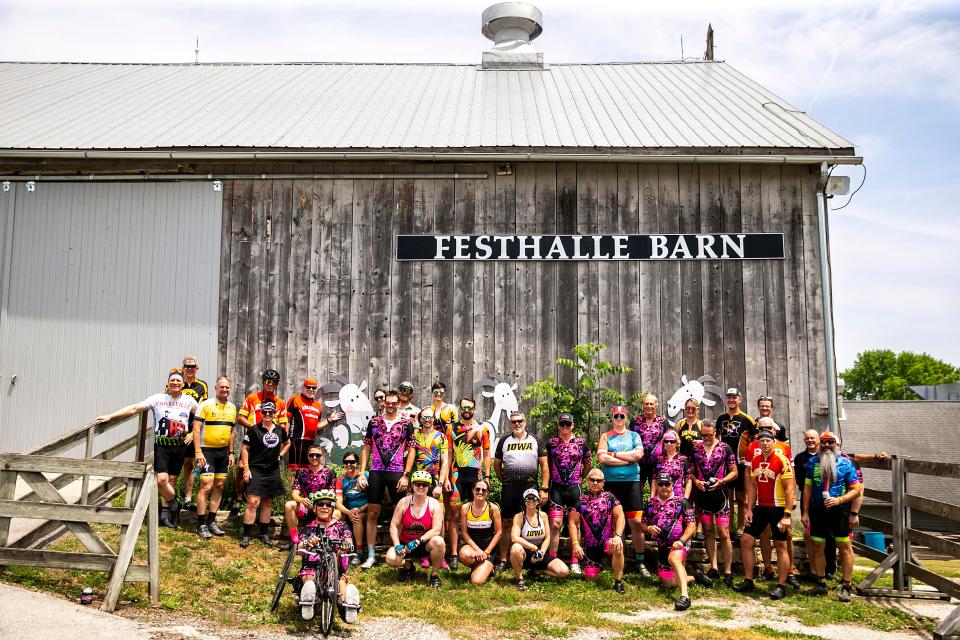
1 p.m. Friday
Willkommen to Amana
RAGBRAI's route inspection team arrived in Amana just before 1 p.m., more than an hour ahead of schedule, as they continued scouting and finalizing the route that more than 28,000 riders will navigate in July.
Amana has not been a part of RAGBRAI's route since 1991, meaning even some of the most dedicated veteran riders will have never gone through one of Iowa's most acclaimed tourist spot, founded along with a cluster of other villages ― the Amana Colonies ― by a German communal religious group in the 19th century.
While only 388 people live in Amana, the town attracts throngs of visitors throughout the year. The seven villages within the colonies were declared a National Historic Landmark in 1967, and the colonies' website touts them as a place where "the past is cherished and hospitality is a way of life."
Amana has the admiration of its rivals, including the ride's ultimate destination today, Coralville.
“This town has very hospitable folks,” Kelly Hayworth, Coralville’s city administrator, told the Iowa City Press-Citizen. “The colonies are awesome. There’s lots to see and do here and riders, they are going to be really surprised.”
Those along on the test ride sat in the shade and took in the Old World feel of Amana, including snapping a photograph in front of the Festhalle Barn, a historic event space, before continuing down Route 151 enroute to Oxford. They're running about half an hour ahead of schedule today as they depart, just after 2 p.m.
― Ryan Hansen
What's ahead on Day 6
6 a.m. Friday
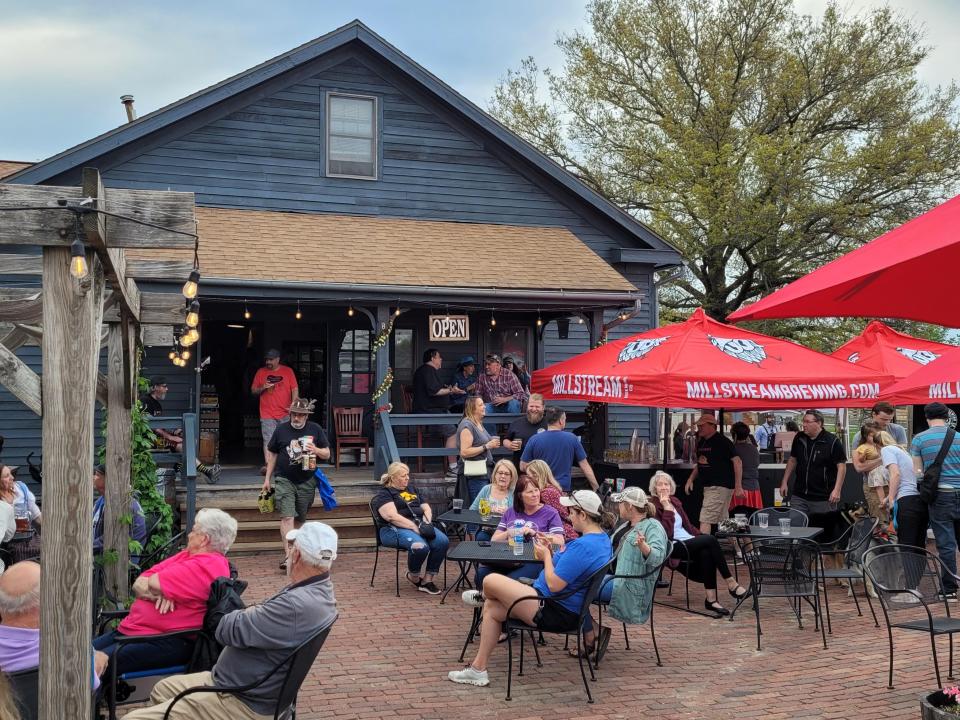
It’s the penultimate day, a big one concluding in Coralville, part of the Iowa City metro area. It’s another long journey after the ride’s longest day Thursday, but with some great stops along the way. We’re especially looking forward to the Amana colonies, seven towns that once were part of a German-immigrant religious commune. They all have their appeal, but the most tourist-friendly is the pass-through town of Amana, with German restaurants and bakeries; Millstream, Iowa’s oldest craft brewery; a smokehouse; a woolen mill; a history museum; and a National Park Service office. It’s one of Iowa’s true tourism gems, and it seems a bit of a mystery as to why it’s only been on the RAGBRAI route twice before, in 1991 as an overnight town and in 1976 as a pass-through town.
Today’s route
Tama-Toledo to Coralville
Miles: 82
Climb: 3,303 feet
Meeting town: Marengo
Pass-through towns: Chelsea, Belle Plaine, Amana and Oxford
What to know: It’s no secret that RAGBRAI likes its classic rock. That’s reflected in the musical lineup for this year’s ride, which includes Lynyrd Skynyrd in Des Moines, whose peak era ended with a tragic airplane crash in 1977, and Foghat in Tama-Toledo, which had its biggest hit, “Slow Ride,” in 1975. So the featured band in Coralville on July 28, Bush, will represent something of a departure. A post-grunge band, its biggest hit was “Glycerine” in 1994, and it released a record as recently as 2022. That seems appropriate for a metro area that has one of the youngest populations per capita, with a median age of just over 26.
DAY 5
6 p.m. Thursday
Hills a poppin' on Des Moines-to-Tama-Toledo route
For those on the RAGBRAI 50th anniversary route inspection ride, Thursday's Day 5 journey was both the longest and most scenic yet.
In over 4,000 feet of climb over nearly 87 miles between Water Works Park in Des Moines and the overnight stop of Tama-Toledo, we saw some of the most spectacular greenery that Iowa has to offer.
The elevation gain was the most of the ride, but it wasn't the killer it appeared to be on paper. Leaving Des Moines we climbed a steep hill near the Iowa State Fairgrounds and up a few other sizable hills. A two-mile stretch halfway between Kellogg and Grinnell has two climbs of about one mile in length. The hilliest section comes near the end of a long day about midway between Grinnell and the overnight stop, Tama-Toledo.
Most of the other hills are rolling, which even with strong crosswinds can be conquered without maximum effort. Six miles of downhills and flatlands greet riders as they roll into Tama County. So while July 27 could be the toughest day of the week on RAGBRAI, it also may be the most rewarding.
― Philip Joens
12:30 p.m. Thursday
Out for a slide
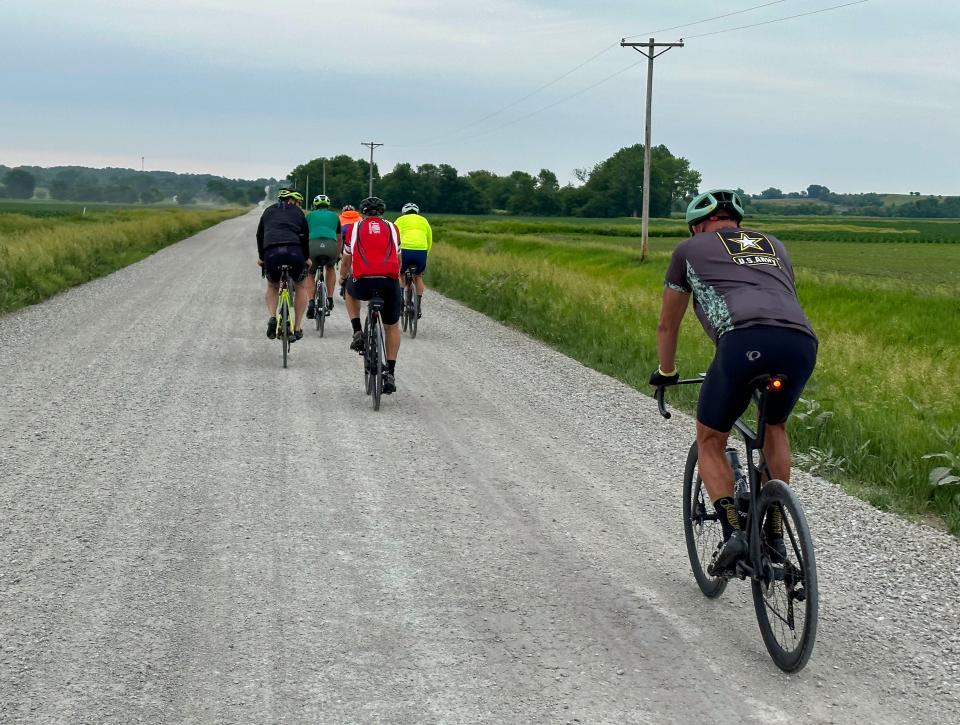
Riding a road bike on gravel is not easy. But wading through a creek, carrying a bike, is harder.
So riders on Day 5 of this year's Register's Annual Great Bicycle Ride Across Iowa will take a 2.5-mile detour on an unpaved road to get to the pass-through town of Colfax. That's because a bridge on County Road F-48 over Squaw Creek is out.
It's not an unprecedented situation. Over its 50 years, RAGBRAI occasionally has been routed onto gravel roads when paved roads were blocked and alternatives would be too dangerous for cyclists.
Ride director Matt Phippen said that without using the stretch of gravel, RAGBRAI would not be able to visit Colfax, which signed on to be a pass-through town before it was apparent the bridge would be closed for repairs this summer.
In 2022, bridge construction between Wesley and Hutchins forced riders to walk their bikes along a short dirt road used by construction vehicles. In Colfax’s case, that wasn't possible, Phippen said.
He said organizers will make every effort to ensure the gravel stretch is navigable for all kinds of bikes. As in 2002, when riders had to travel a 2-mile stretch of gravel, Phippen said, ride organizers will seek to ensure any gravel is either scraped off the road or hard-packed.
“We’re going to work with the county," he said. "They’re going to help scrape it off. It’s not terrible, but it’s 2 miles. Those 2 miles will get riders into a town that is super excited to have RAGBRAI riders.”
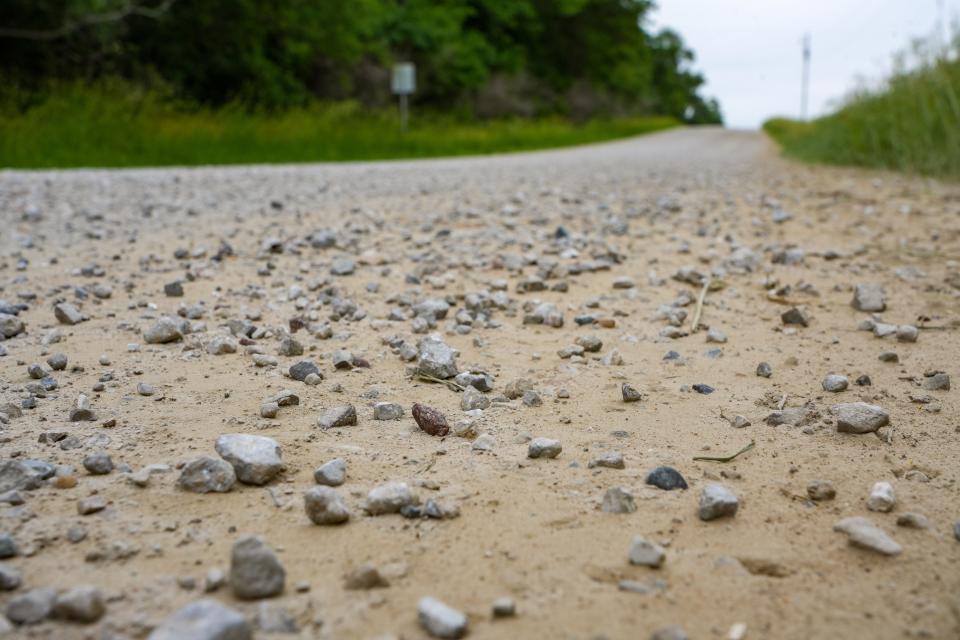
Personally, on Thursday’s RAGBRAI route inspection ride, I felt terrified riding the gravel surface on my road bike's skinny, high-pressure tires, my riding shoes clipped onto my pedals. Even riders on gravel bikes, when on pavement, point out spots of loose gravel to one another so nobody hits it unaware and slides out of control.
The unscraped portion where I first encountered the gravel after leaving the pavement was a reminder of that hazard. It was dusty, and the stones felt loose and slippery.
But further along we came to scraped portions, which felt like a solid, if bumpy, road. Still, I treaded like a scared cat, going 6-8 mph as compared to my usual 20-plus. At my fastest I only reached 12 mph, and that was to get out of the way of a semi-trailer as I passed another rider.
Then came a sight that made my blood run cold: a hill. I imagined losing traction with my treadless tires and ending up sideways, scraped and bloody.
It turned out to be surprisingly easy. Something had scraped the loose rocks away and it felt less bumpy than portions of Des Moines’ Neal Smith Trail, which we rode Wednesday on our way into the city.
But what goes up must come down. With pavement finally in sight, riders had to navigate a small downhill section of loose gravel. Rounding a short turn, I started on the right-hand corner of the road and found myself on stopping out of control on the lefthand corner, only a few feet from the tarmac
It could have been worse. On the Great Six-Day Bicycle Ride, the initial 1973 cross-Iowa journey that evolved into RAGBRAI, route planning was haphazard. One of the 120 people who finished that trip, Stephen Gaul of Slater, said riders encountered unexpected road closures that forced them onto extensive sections of gravel. And he was riding a French road bike weighed down with all of his gear for the week.
“There’s a couple places where we had to take some gravel because a bridge was out or they were preparing a bridge and didn’t tell them about it,” Gaul said.
And in 1994, RAGBRAI took riders on 14 miles of gravel over four days.
Take the advice of late RAGBRAI Co-Founder John Karras, who wrote of gravel riding in 1994, “Maintain a steady pace, rest your hands lightly on the tops of the handlebars and let the front wheel find its way through the gravel.”
Phippen acknowledged that the gravel is “pretty difficult to ride” for those who don't have specially adapted bikes.
“You’re riding on loose rocks. So if you lose focus for one second, hit a big rock, you’re tired and you could go down,” he said.
― Philip Joens
7:30 a.m. Thursday
Paying tribute to the founders
After spending Wednesday night in Des Moines, riders on the inspection of the 50th anniversary RAGBRAI route began Thursday morning with a visit to the sculpture honoring late ride founders John Karras and Donald Kaul in Water Works Park, where the tens of thousands of riders coming through the city on July 26 will camp.
Kaul died in 2018 and Karras in 2021. The $200,000 bronze and aluminum installation depicts the pair of Register journalists with their bikes, initiating the annual Missouri River tire dip that is now a ritual part of the start of the Register's Annual Great Bicycle Ride Across Iowa.
An inscription lists the 133 towns and cities across Iowa that had hosted riders before 2021, and credits Karras and Kaul with putting "the world's largest, longest and oldest recreational bicycle touring event" on "every enthusiastic bicyclist's bucket list."
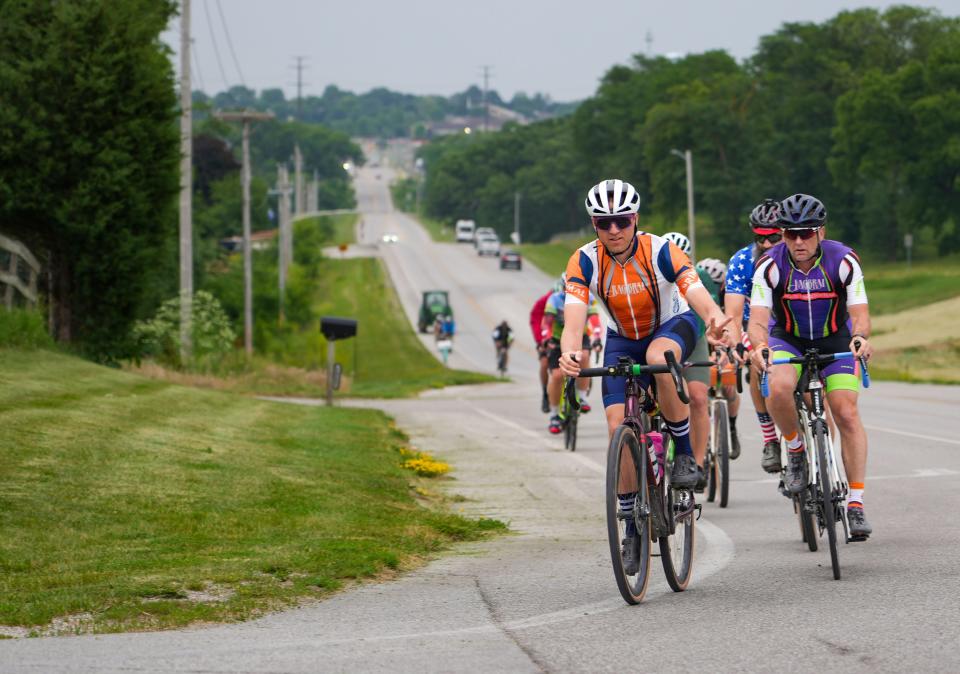
After paying their respects, the riders mounted up and got under way on their journey to the first pass-through town of the day, Altoona. The ride also passes through Pleasant Hill on the way there, but with the most miles of any day to cover ― almost 87 ― ride director Matt Phippen said the decision was made to keep the riders moving, foregoing a stop there.
― Philip Joens
6 a.m. Thursday
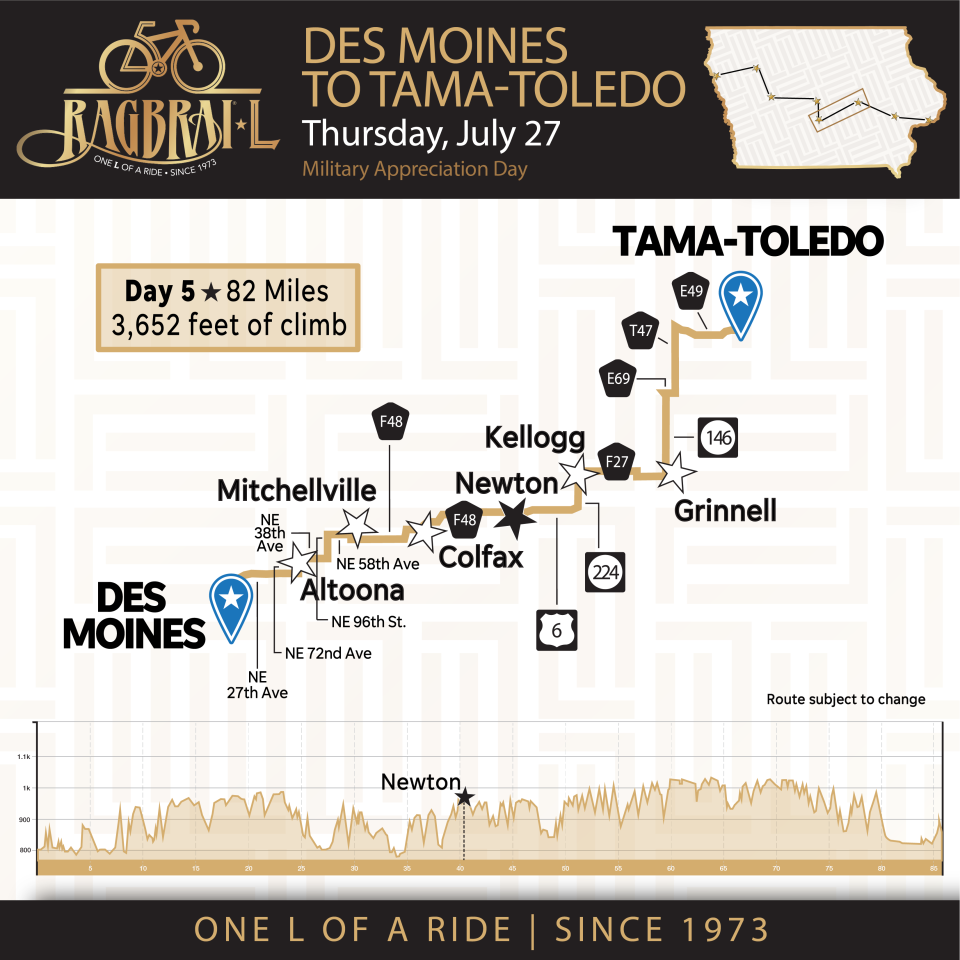
RAGBRAI riders who stay up late to party Wednesday night in Des Moines may regret it: The route we’ll be following today will likely be one of the most challenging of the ride. It starts with an occasionally steep ascent out of the Des Moines River valley to Altoona, the breakfast stop, then follows plenty more bumpy terrain. Most of the hills aren’t as steep or long as some of those on Day 1, when the route climbs out of the Missouri River valley. But it adds up to the most feet of climb for any day of the ride, as well as the most mileage.
The overnight destination is the smallest on the route: the twin cities of Tama-Toledo, combined population 5,400. It’s not one of the stops from the original 1973 route, but the equivalent overnight on that year’s six-day ride was the even smaller Williamsburg. Still, the Tama-Toledo RAGBRAI campground is well-situated, near a commercial hub between the two cities that includes a supermarket, several convenience stores and cluster of restaurants.
Today’s route
Des Moines to Tama-Toledo
Miles: 86.8
Climb: 4,140 feet
Meeting town: Newton
Pass-through towns: Altoona, Mitchellville, Colfax, Kellogg and Grinnell
What to know: A few miles east of Tama-Toledo is the Meskwaki Settlement of the Sac and Fox Tribe of the Mississippi in Iowa. The Meskwaki were among indigenous groups forced out of Iowa to a Kansas reservation in the 1840s, but some stayed behind and others eventually returned. Over time, they acquired the land for the village, one of the most significant representations of native people remaining in Iowa. It includes a cultural center and museum and a casino hotel.
12:50 p.m. Wednesday
Arriving in Des Moines
A hot day for riders on the RAGBRAI route inspection team briefly turned cool Wednesday, with light rain falling as they rode into Ankeny with a police escort.
The main stop was a pizza and beer lunch at Uptown Garage Brewing, where they were impressed by the spacious adaption of a former auto shop.

The actual RAGBRAI ride is supposed to proceed from Ankeny to Des Moines on July 26 via U.S. 69, known as Ankeny Boulevard in Ankeny and East 14th Street in Des Moines. But without the Iowa State Patrol troopers who will provide traffic control during that ride, members of the inspection team instead opted for a scenic ride down the Neal Smith Trail to RAGBRAI headquarters just east of downtown Des Moines, with a stop, of course, at Des Moines cycling landmark Captain Roy's in Birdland Park on the Des Moines River.
It was the shortest day of the inspection ride, with about 50 miles covered.
― Philip Joens
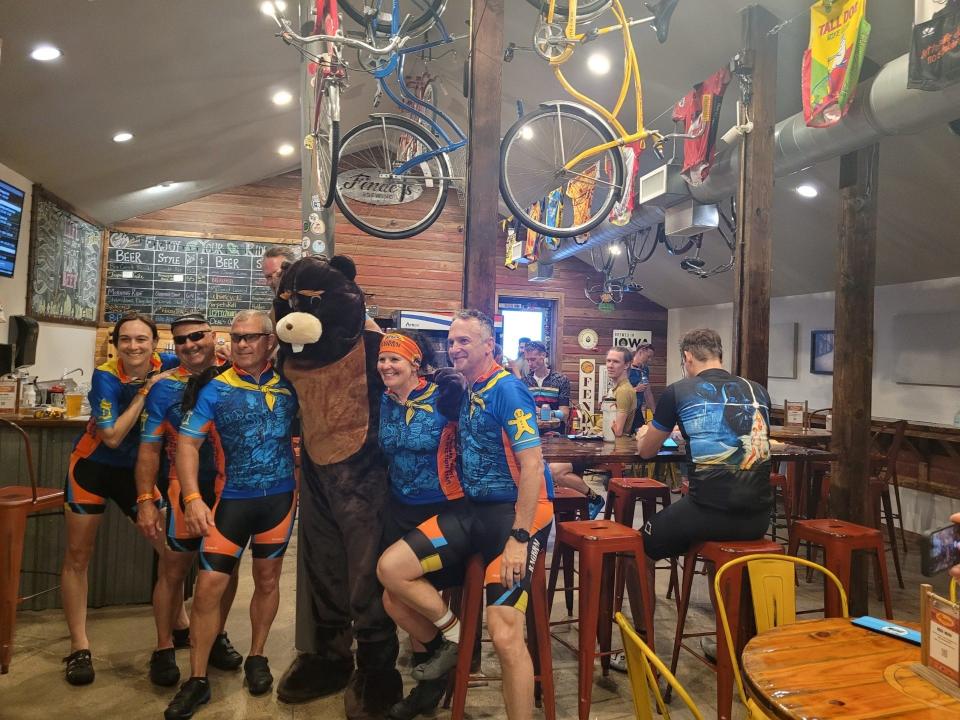
12 p.m. Wednesday
'Dam good time' in Polk City
As the RAGBRAI route inspection team rolled into Polk City, Mayor Steve Karsjen said cycling could help the fast-growing Des Moines metro town.
The High Trestle Trail runs just east of the city to Woodward, Madrid, Slater and Ankeny. The Neal Smith Trail runs just south of town. Polk City is working to connect the two trails, he said.
Polk City is preparing to host 60,000 people on July 26, Karsjen said. Like the leaders of other towns on the route, he said the community is not scared of the big figures.
“Cycling is very much in our planning for the future,” he said. “We want to promote Polk City as central Iowa’s recreation destination.”
As the costumed Polk City beaver reminded the visiting cyclists, the community between Saylorville and Big Creek lakes is a great place to have a "dam good time."
― Philip Joens
11 a.m. Wednesday
Rider from 1973 greets route inspection team in Slater
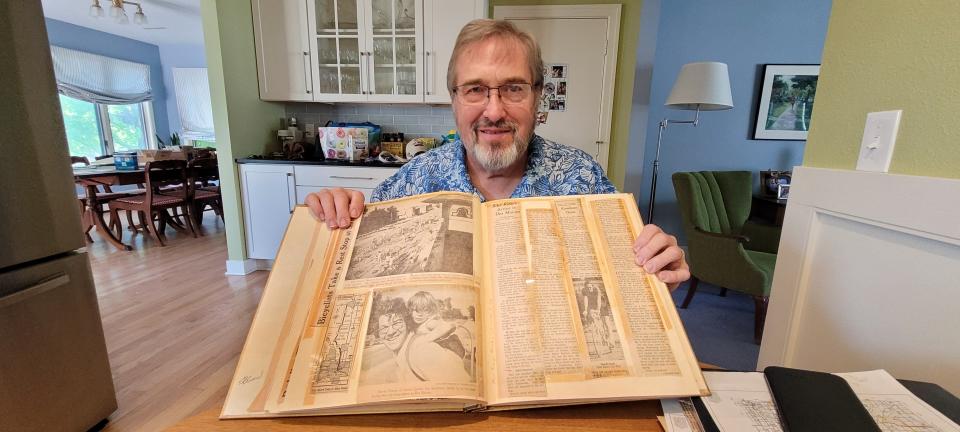
Almost 50 years ago when Stephen Gaul rode onto Main Street in Slater on the Great Six Day Bicycle Ride, he had no idea that he would later call it home.
Gaul, now 68, moved to Slater in 1985 in the midst of a long career as a microbiologist at Iowa State University. His wife was a Grand View University professor and living in Slater put them in the middle of their commutes.
But when he first saw the town on Aug. 29, 1973, he was just an 18 year old taking a gap year and lucky enough not be fighting in the Vietnam War.
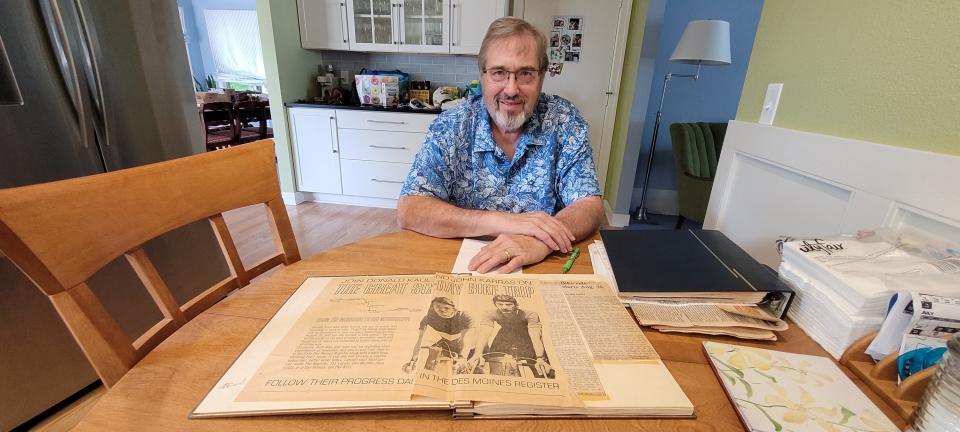
He was on hand Wednesday morning when the route inspection team for the Register's Annual Great Bicycle Ride Across Iowa, which that 1973 ride launched, arrived to see how its preparations for the this year's 50th anniversary ride were going.
Gaul regaled the riders with tales of his experiences on that initial ride. In particular, he recalled that his future home left him deflated ― literally.
“I got my flat tire crossing the (train) tracks coming into Slater,” Gaul said, the only one he had that week. “Luckily I just had to peel it off, put the new one on, pump it up and about 10 minutes later I was running again.”
In the summer of 1973 Gaul commuted by bike between a job in West Lake Okoboji and his parents’ house in Spencer. Conscription into the U.S. armed forces ended in January 1973, and Gaul had a low enough draft number that he was spared from service before then, he said.
After graduating from Spencer High School, he took a year off so he could work and save money for college. Then he saw stories in the Des Moines Register promoting The Great Six-Day Bicycle Ride.
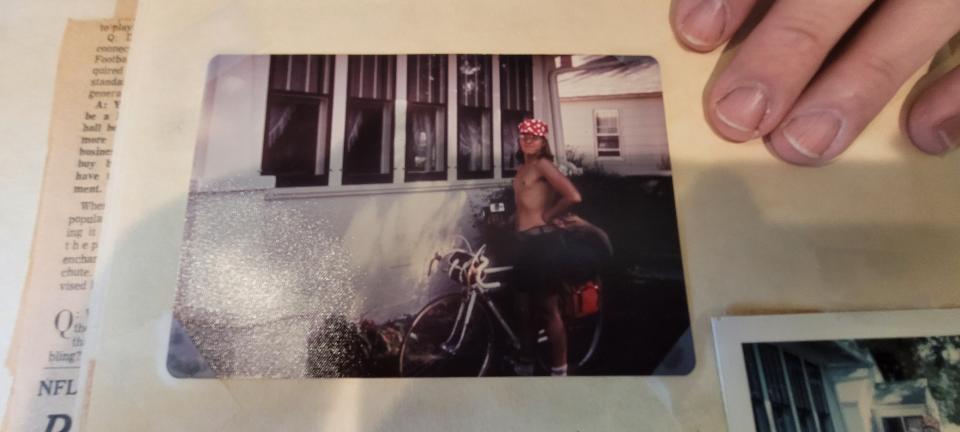
“I decided I want an adventure. I graduated from high school. I’m going to college. I want to do something exciting first,” he said.
Gaul carried his tent, clothes and 40 pounds of gear on the back of his 10-speed, French-built bike.
Gaul wore cutoff shorts because bike shorts were not popular yet. Instead of a helmet he wore a red and white train conductor’s hat so he could “be seen” by cars. He brought $100 to cover his expenses but did not spend it all. He and other riders got food at gas stations or other places in towns.
“There were no church suppers yet. No churches selling ice cream or pie. So, you had to be responsible for your own meals. No SAG (support-and-gear) wagon to pick you up. No somebody taking your stuff to the next town. It was completely different than it is now.”
Like this year, the shortest day was on Wednesday between Ames and Des Moines.
“That’s when we had the most people,” Gaul said. “Almost 500 bicyclists… It seemed so crowded between Ames and Des Moines.”
When RAGBRAI returns to downtown Slater on July 26, there could well more than 100 times as many people.
Despite the crowd that day, when Gaul finished the ride at Vander Veer Park on the Mississippi River in Davenport he was one of only 120 people who had ridden all the way from Sioux City. Gaul rode RAGBRAI again in 1991 and 1993, thought he said it felt “crowded.”
Today Gaul still likes to ride, though a bad knee prevents him from going more than 5 miles at a time. But over the years his experience on the Great Six-Day Bicycle Ride inspired him to do longer rides.
“I felt like I was accomplishing something as a youth, something that not many people would do at the time,” Gaul said.
― Philip Joens
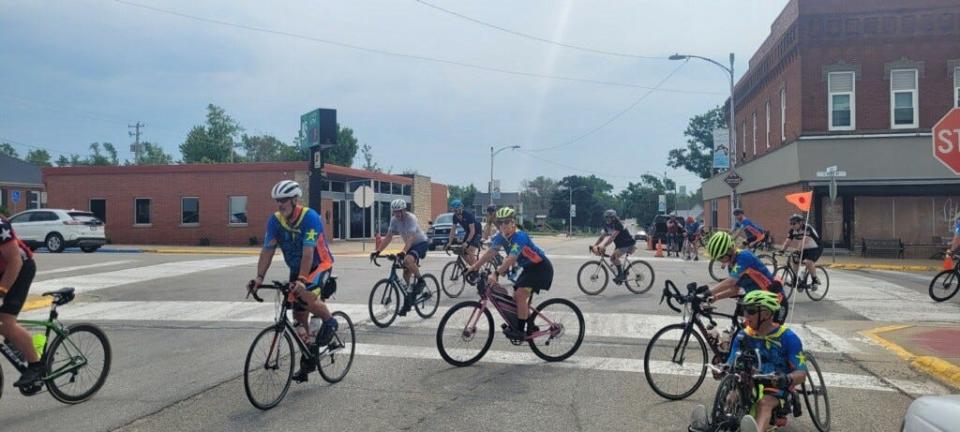
10 a.m. Wednesday
Cycling central to Madrid's economy
Riders on the RAGBRAI Route Inspection Ride cruised into Slater and Madrid Wednesday morning with picture perfect conditions. Riders arrived in Slater almost an hour ahead of schedule. Slater is trying to raise $7 million for a new library, said Jennifer Davies with the city. The town already has raised $1.5 million, Davies said.
Madrid built its economy on coal mining, but the city “struggled to find its identity” as mining ended, said Don Lincoln with the Madrid Chamber of Commerce, a 67-year resident and former longtime City Council member.
“All of a sudden, the High Trestle Trail falls right in our lap,” Lincoln said of the construction of Iowa's most popular biking trail, with its iconic, 140-foot-tall bridge across the Des Moines River just west of town.
The bridge's railroad deck and been stripped and “all it was was the pillars,” he recalled.
Now the trail and bridge draw hundreds of thousands of visitors annually, and hosting RAGBRAI as a pass-through town will help Madrid celebrate how important cycling is to its economy, Lincoln said.
Weather allowing, July 26 could bring up to 100,000 riders to Madrid, according to RAGBRAI organizers.
“Bring them on,” Lincoln said. “That’s a bunch of people. It will be good for the local economy.”
― Philip Joens
DAY 4
6 a.m. Wednesday
What's ahead on Day 4
This is the big day! We’ll be riding to Des Moines on the route that will bring the 50th anniversary RAGBRAI back to the place where the idea for it was first hatched by Register journalists John Karras and Donald Kaul. Des Moines was, of course, an overnight town on the very first ride in 1973, but the route hasn’t taken riders through the city since 2013, coming closest in 2019 when it passed through Norwalk on the way to Indianola. We’ll also visit Ankeny before pedaling past the gold-domed Iowa Capitol. What will be the route from the Capitol to the campground at Water Works Park for a crowd swelled by thousands of one-day participants taking part in the historic ride? Stay tuned for details.
Today’s route
Ames to Des Moines
Miles: 50
Climb: 1,216 feetMeeting town: Ankeny
Pass-through towns: Slater, Madrid and Polk City
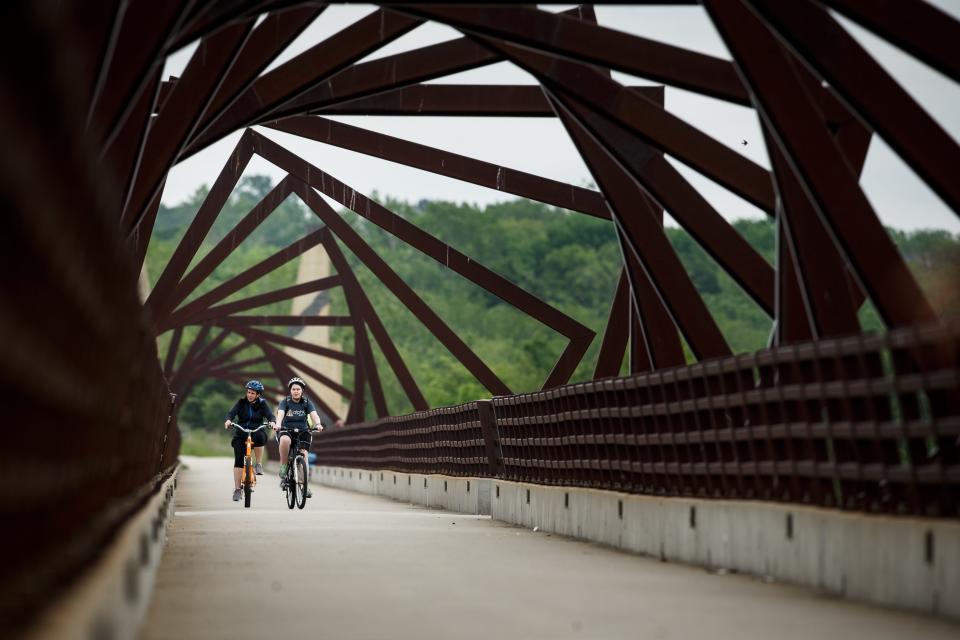
What to know: RAGBRAI officially is not encouraging any detours from the route. But when the ride passes through Slater on July 26, it will bring riders to within a few easy miles of Iowa’s most iconic cycling landmark, the High Trestle Trail Bridge across the Des Moines River, via the wide, paved High Trestle trail. The chance to see the spectacular bridge, with its sweeping vista of the river valley, will be hard to resist if the weather is right.
DAY 3
4:15 p.m. Tuesday

Waiting for the RAGBRAI route inspection riders, Gwen Page of pass-through town Luther's popular Whatcha Smokin' BBQ + Brew had a sumptuous repast awaiting them: brisket sliders, baked beans and cornbread. She said she expects the July 25 visit by RAGBRAI to be the business' biggest day since it opened in 2017, and has ordered 14,000 pounds of meat to make 46,000 sandwiches: 30% brisket and 70% pulled pork. That compares to selling about 200 pounds of brisket on a very busy Saturday.
How is she planning to get through the day? “Hard work and prayer,” she said.
― Teresa Albertson
4 p.m. Tuesday
Iowa's ever-changing weather
Dixon Novy of the Quad Cities, making his sixth RAGBRAI route inspection ride, reached the rest stop at the city park in Luther full of appreciation for the day's perfect weather. “The wind is nice. It’s perfect. This is the first day we have had a tailwind pushing us across,” he said. But Iowa weather is always changing, and an hour later, the riders were huddled under the main entrance overhang at Ames Middle School waiting for a summer storm to pass.
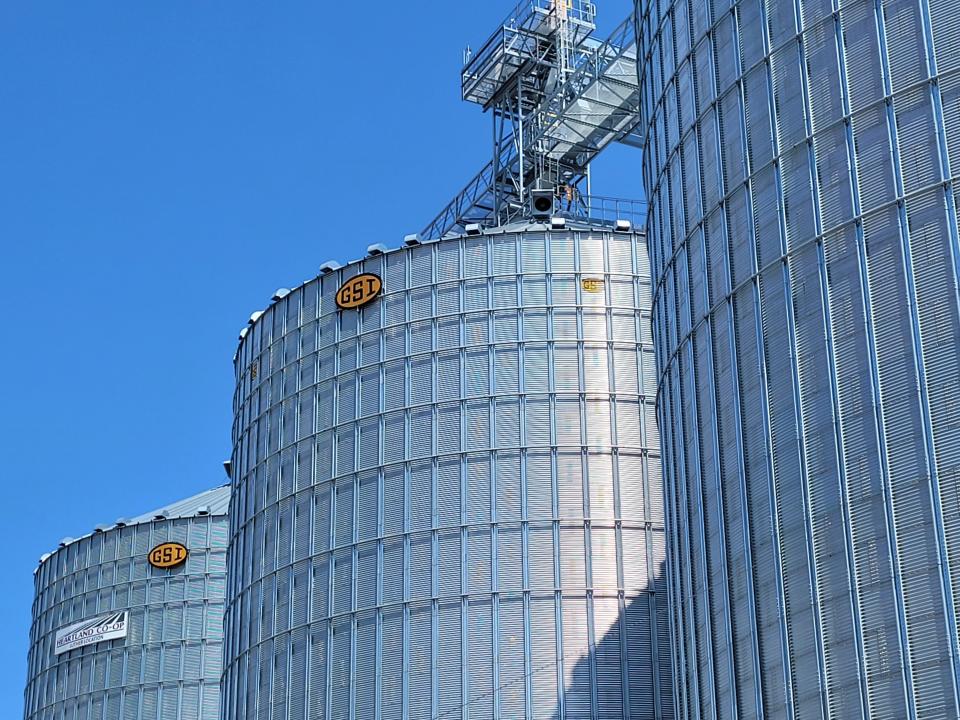
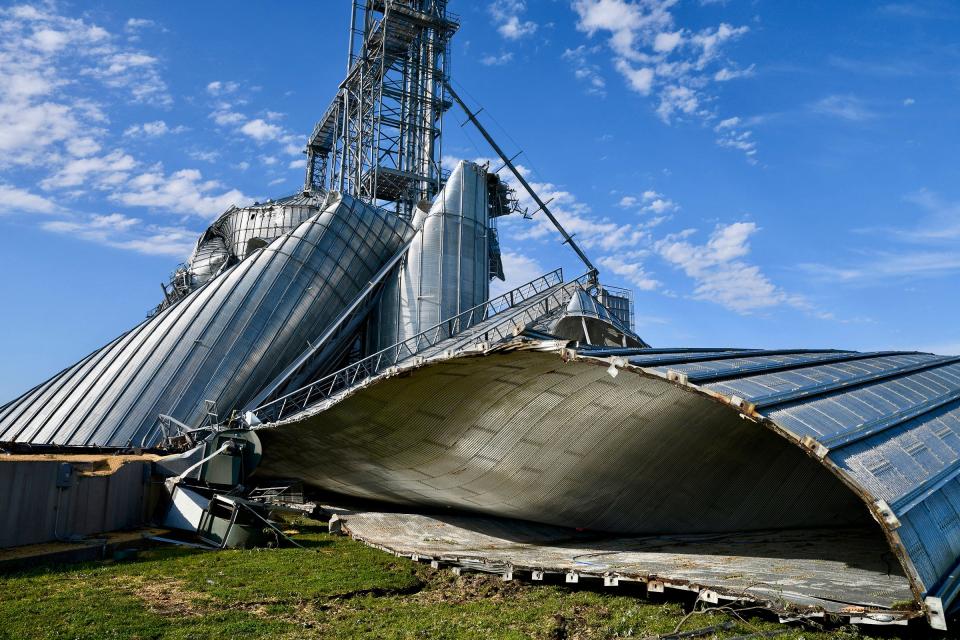
At least it was nothing more than a passing thunderstorm. Luther bears a reminder of one of the fiercest storms in Iowa's memory, the August 2020 derecho that packed 140 mph winds and brought catastrophic damage to communities across the state. Towering over Fifth Avenue, where the route inspection team entered the town, are three giant metal grain bins. Since repaired, their shredded remains were an iconic symbol of the storm's power.
― Teresa Albertson
3:45 p.m. Tuesday
Ride of the century
Waiting to greet the RAGBRAI route inspection riders in the pass-through town of Luther was Boone County Supervisor Eric Kretzinger. He said he rides about 2,000 miles on his bicycle every summer and went on three or four RAGBRAIs, but quit because he got tired of the crowds and sleeping on the ground. However, this year he will be joining the Ride for one day for the century loop, which loops through the Boone County countryside. Members of the team surveyed it Tuesday and pronounced it the most scenic part of the 50th anniversary route so far.
― Teresa Albertson
3:15 p.m. Tuesday
What goes down must come up
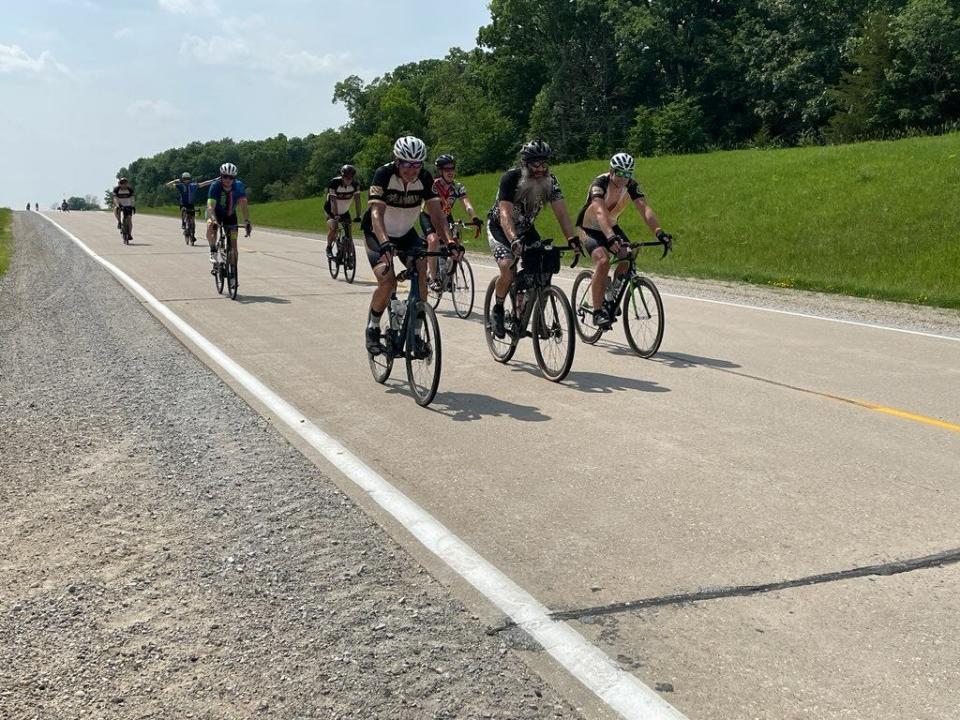
One of the big challenges of the day was descending into the Des Moines River valley ― and then climbing back out, a combination of daring and endurance. Scott Olsen said after reaching the other side that he was not going quite full speed on the way down. “You have to eventually stop peddling because you’re going too fast for your bicycle to keep up.” His strategy climbing up out of the valley was “just to beat these two,” he said gesturing to Dave Edwards and Corey Mutch next to him. Scott Matter, on the other hand, never stopped pedaling, saying his technique was to go full speed on the way down and just keep up the momentum on the way back up
― Teresa Albertson
6 a.m. Tuesday
What's ahead on Day 3
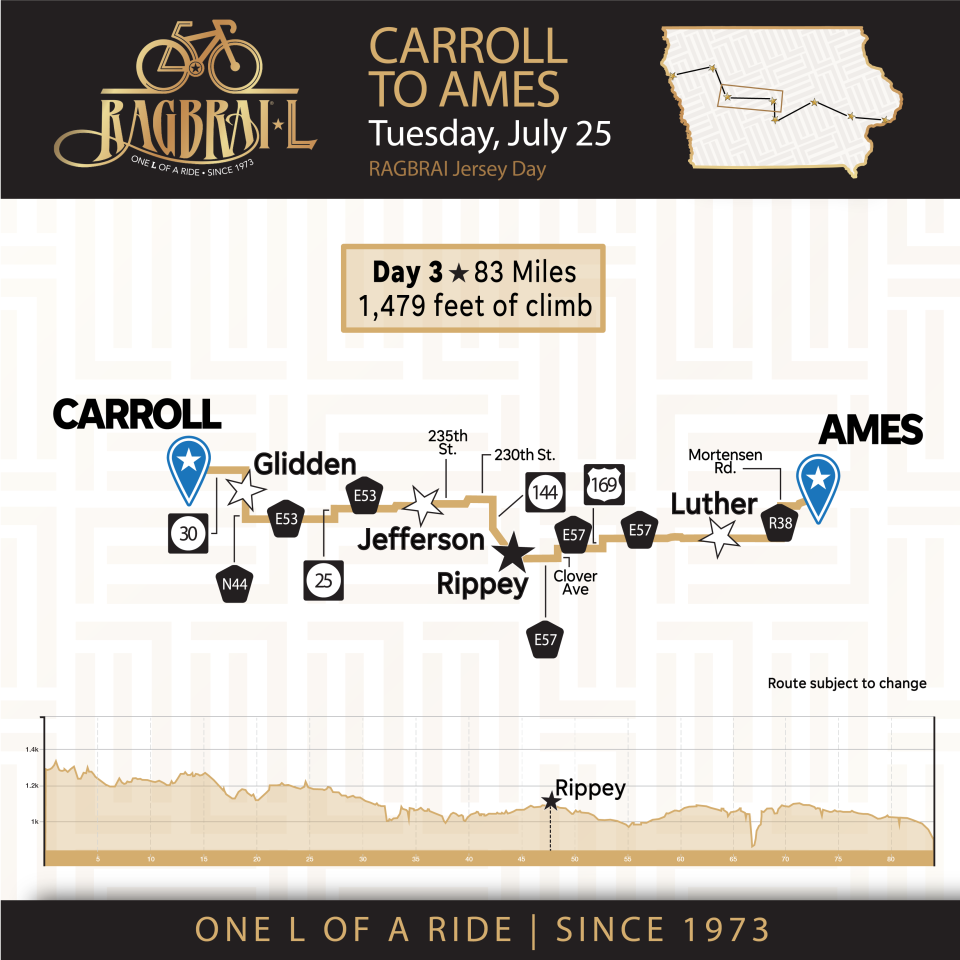
Most RAGBRAI routes spend a substantial amount of time in Iowa’s smaller towns as they wend their way across the countryside. That’s not a bad thing ― experiencing their warmth and hospitality is part of what makes the Register's Annual Great Bicycle Ride Across Iowa unique. But it’s also fun sometimes to sample the variety of Iowa’s biggest cities. This year’s 50th anniversary route is an urban cornucopia, visiting five of Iowa’s nine regions populous enough to be classified as metro areas. It starts in Sioux City, ends in Davenport and makes overnight stops in Des Moines, Coralville in metro Iowa City and today’s destination, Ames. The home of 30,000-student Iowa State University can be a bit sleepy in the summer, but it has plenty of year-round attractions, including a wide variety of eateries offering everything from barbecue to Brazilian cuisine. It’s also likely we’ll get to make a lap round the inside of Jack Trice Stadium, home field of Cyclones football. The stadium ride will be one of the highlights of RAGBRAI Day 3.
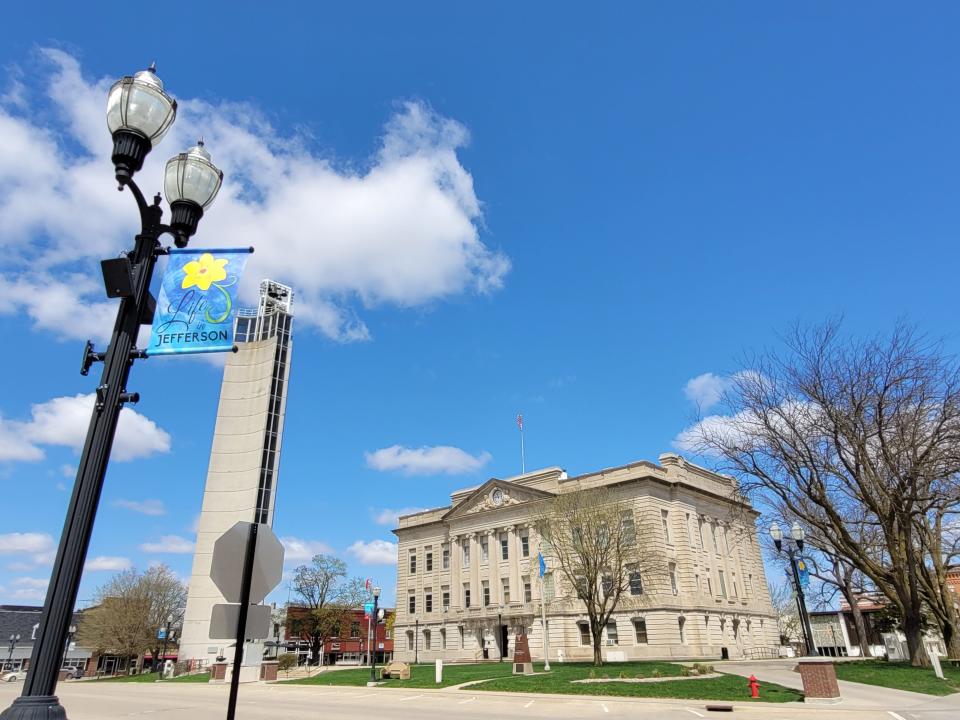
Along the way, we’ll also visit Jefferson, home to the Mahanay Memorial Carillon Tower ― which, by the way, will be celebrated with an annual festival this Friday and Saturday. The nearly 170-foot tower has an observation deck, and its bells sound out in a daily concert at 12:15 p.m.
Today’s route
Carroll to Ames
Miles: 83
Climb: 1,479 feet
Meeting town: Rippey
Pass-through towns: Glidden, Jefferson and Luther
What to know: Today’s elevation gain is moderate compared to the last two days’. But there’s at least one heavy-duty pull when the route crosses the Des Moines River between Rippey and Luther. Iowa’s largest inland river flows through a deep valley amid the prairie. Some of us will be traveling at top speed on the way down to the bridge, while the more cautious among us will be burning our brakes. All of us, though, will be exploring the lowest reaches of our groupsets as we chug up the 6% grade on the other side.
DAY 2
4:30 p.m. Monday
SAGging again for safety
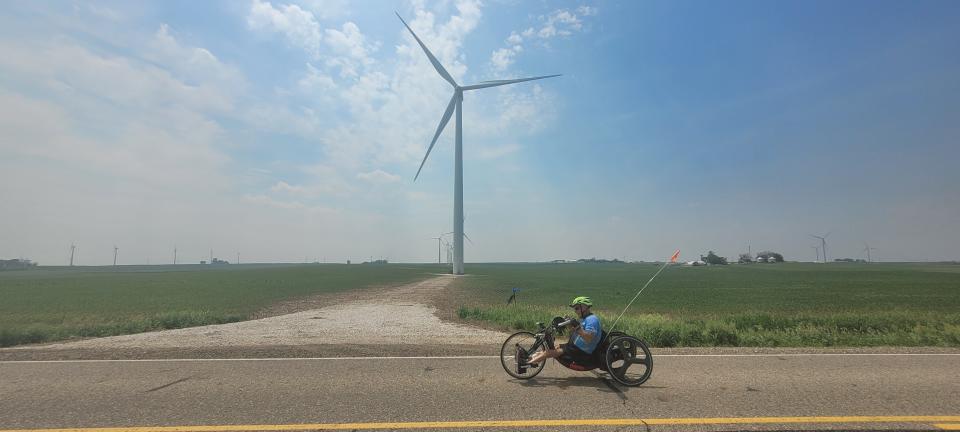
For a second consecutive day, the RAGBRAI route inspection team ended its day in the SAG wagons. On Sunday, the reason for taking to the support-and-gear vans was a lightning storm that halted the ride short of overnight destination Storm Lake. On Monday, it was the prospect of riding with heavy, high-speed car and truck traffic on a 5-mile stretch of U.S. 71 from pass-through town Mount Carmel to the overnight town of Carroll.
If the road is part of the final route, the Iowa State Patrol will ensure it's safe for cyclists. But there was no such assurance on Monday, and no need to take a risk after an otherwise scenic ride through hills studded with giant wind turbines.
4 p.m. Monday
Breda: Can you spare a dime?
Day 2 pass-though town Breda will tap RAGBRAI riders to help its raise money for improvements to its decades-old Little League and high school baseball stadium.
Leon Tiefenthaler with Breda’s RAGBRAI organizing committee, who turned out to greet the route inspection team as it visited the town on Monday, said the facility dates back to at least the 1950s. The town is looking to raise $300,000 to replace lights at the ballpark before it celebrates its 150th anniversary in 2027, Tiefenthaler said. The park also needs replacements for some rotted wooden beams and a rusted steel roof, he said.
Breda residents don’t expect to raise the full amount from RAGBRAI, but with every organization pitching in, they hope to get the fundraising off to a good start.
And the Register's Annual Great Bicycle Ride Across Iowa has inspired fundraising miracles on occasion. In 2021, the tiny northwest Iowa crossroads of Lytton staged goat yoga sessions ― yoga with baby goats ― charming riders enough (along with a pie sale) to raise $15,000 toward a new firehouse. That so impressed Ankeny's famously philanthropic Lauridsen family, which has an animal protein plant in Lytton, that they paid off the remaining $50,000 debt on the project.
Tiefenthaler said that Breda, population about 500, is trying to engage the young people that still live there. He was among the organizers the last time RAGBRAI came through Breda in 1994, and said hosting the ride is a good way to get new people interested in the community before the sesquicentennial bash.
“You see so many communities that are little and pretty soon they’re pretty well gone by the wayside,” Tiefenthaler said. “The RAGBRAI is a good way to get people involved.
Noon Monday
Less terrain doesn't mean less scenery
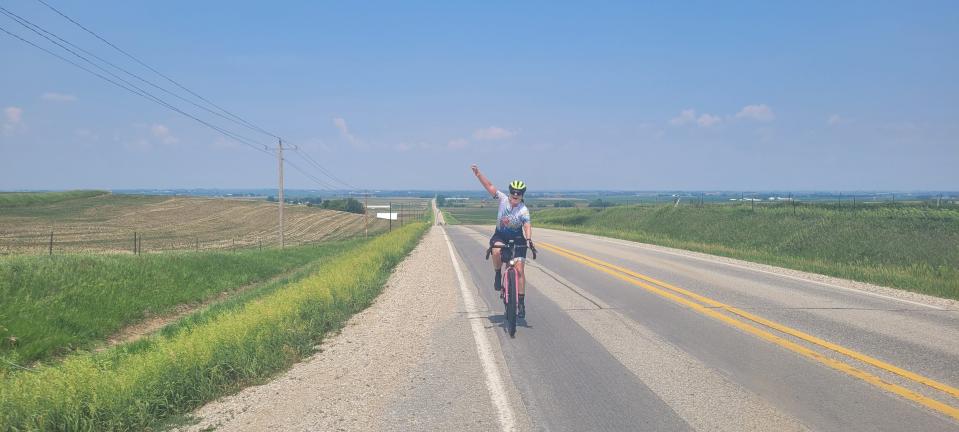
Sunday's ride was a long, hard pull. Monday's terrain, though far from flat, is ess rugged, yet even more scenic. From Storm Lake to Breda, it offers long-range views of the rolling hills and prairies. Midway is the meeting town of Lake View, an unexpected resort amid the cornfields on a beautiful natural lake with a state park. Riders may be tempted to return sometime to pedal the 33-mile Sauk Rail linking Lake View and Carroll.
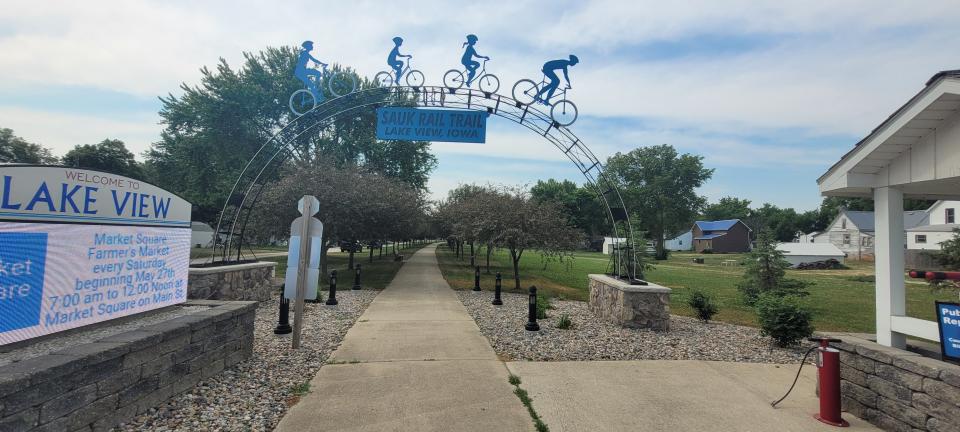
― Philip Joens
8:30 a.m. Monday
Gravel envy
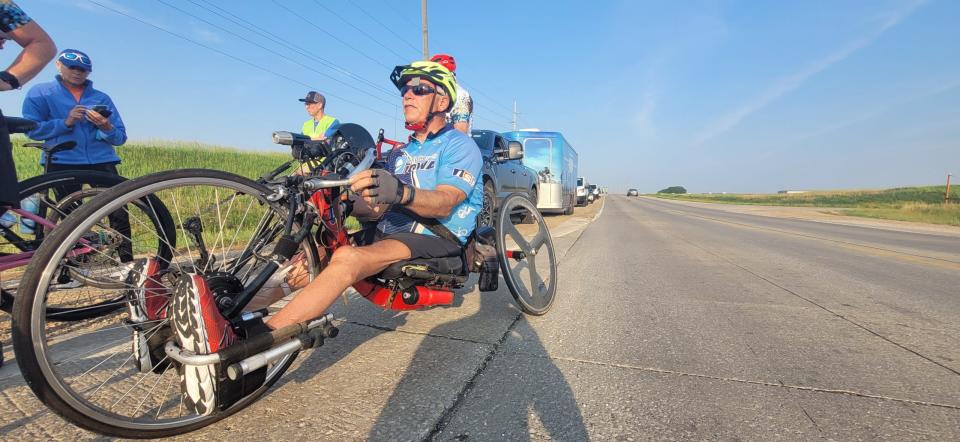
We face a choice as we start Day 2 of the 50th anniversary RAGBRAI route inspection ride.
Those with gravel bikes may peel off after 2 miles to take the optional, 57-mile gravel day route. Running parallel to the paved route, it's sightly shorter, even if it's a bit bumpy. Those of us on road bikes may wish we could have had that option. The 18-mile route to the pass-through town of Early takes us on a stretch of busy U.S. 71. If that's part of the regular route, it presumably will have traffic control from the Iowa State Patrol. But for today, it means riding for an extended period inches from cars and trucks whizzing by at 65 mph (or more).
― Philip Joens
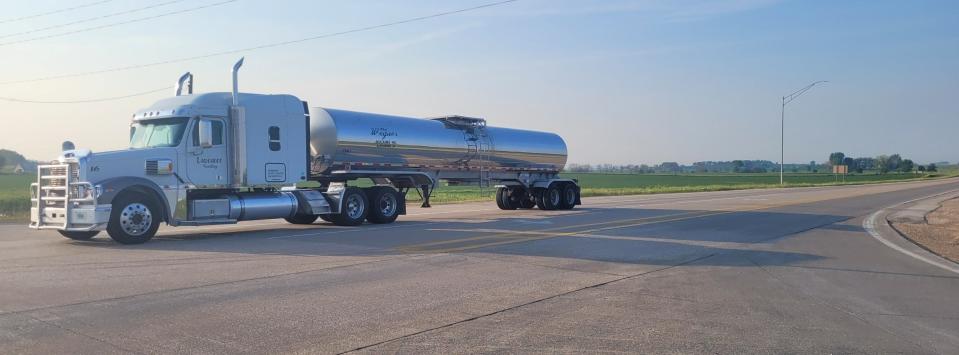
6 a.m. Monday
What's ahead on Day 2
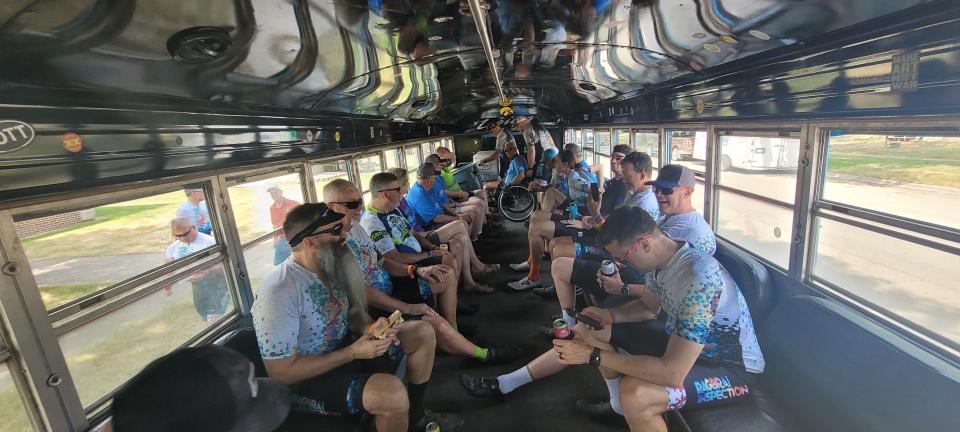
The original 1973 route of the Great Six-Day Bicycle Ride proceeded on Day 2 almost due east from Storm Lake to Fort Dodge. But with seven days to cover instead of six, today’s route inspection ride heads sharply south-southeast, across some of the most scenic rolling hills in northwest Iowa to the pleasant and prosperous overnight town of Carroll. Along the way we’ll navigate the eastern shore of Storm Lake, among the largest of the glacial remnant water bodies in Iowa, then pause near the southernmost in the United States, Black Hawk Lake in the charming meeting town of Lake View. From there, we’ll ride among the towers of one of Iowa’s many wind farms as we aim for the pass-through towns of Breda and unincorporated Mt. Carmel, a tiny crossroads whose outsized Catholic church with a spire topping a high point rivals the wind generators. It’s not far from there to Carroll.
Today’s route
Storm Lake to Carroll
Miles: 62
Climb: 1,818 feet
Meeting town: Lake View
Pass-through towns: Early, Breda and Mt. Carmel
What to know: Carroll has a prominent place in Iowa athletic annals. It’s often the site of state high school baseball tournaments. It’s also home, not far from the RAGBRAI campground, of a basketball court in Veterans Memorial Park that sports the distinctive purple and gold of the Los Angeles Lakers. What’s the story? In January 1960, the Lakers, then a Minneapolis team, were flying home from an away game when their airplane lost its generator, leaving it without lights, radio and navigation. Far off course and running out of fuel, the pilots ditched in a snow-covered cornfield in Carroll. All aboard survived, and the town’s residents, who had heard the clearly troubled plane circling, turned out to feed and shelter the grateful players. In a 2010 50th anniversary tribute, the now-LA team paid $25,000 to build the court.
5 p.m. Sunday
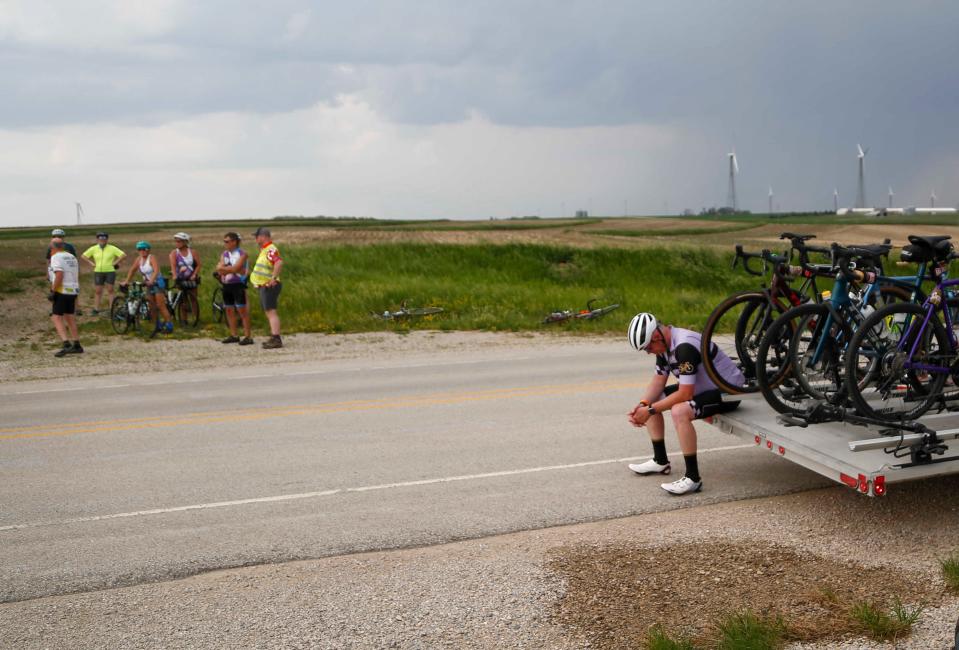
Even the experts know they have to sag sometimes.
Eight miles outside the overnight destination of Storm Lake, after 62 miles of steep hills and headwinds, the about 40 members of the RAGBRAI route inspection crew hit an obstacle they declined to challenge: a threatening lightning storm. We loaded our bikes on the support-and-gear vans (SAG wagons) for a safe ride into town.
It's a reminder that those who join July's ride without buying at least a day pass will be on their own if the weather turns threatening.
The Day 1 route (and Day 2 on Monday) are likely to be the most rural of the ride. Sunday's ride started from Sioux City, population about 85,00. But the route quickly turned into farmland as far as they eye could see, with more than 20 miles between towns.
― Philip Joens
Watermelon Days host to welcome RAGBRAI with guess what?
2:15 p.m. Sunday
Iowa isn't all corn and soybeans.
Quimby has a long tradition of celebrating summer with watermelon. The town's annual Watermelon Days festival hands out 2,000 pounds annually of the refreshing treat on the fourth weekend of June.
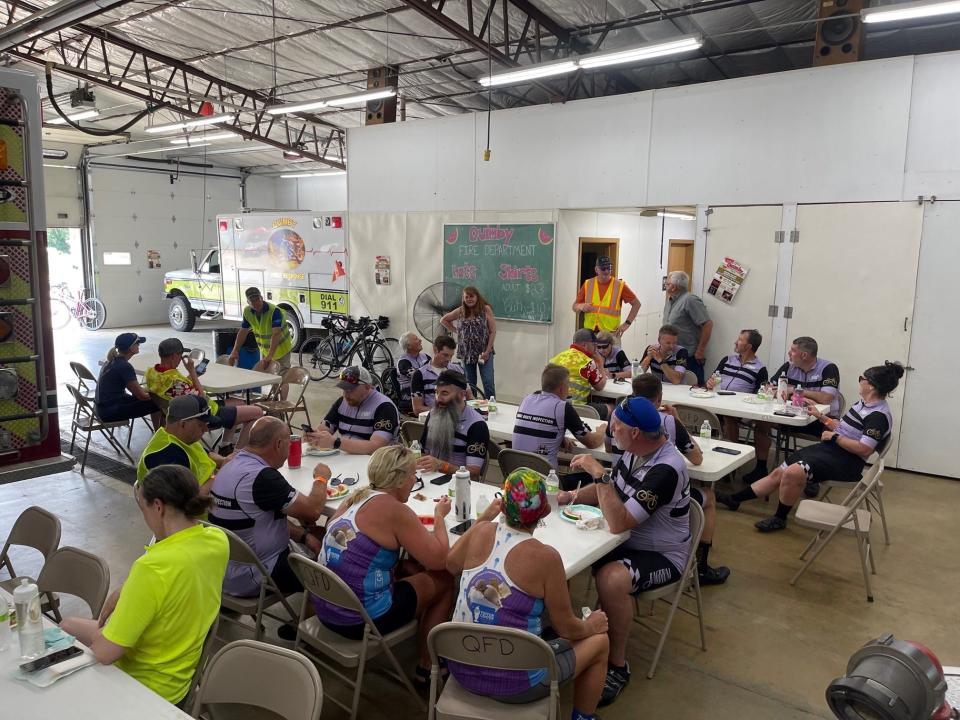
Riders on the 50th anniversary edition of the Register's Annual Great Bicycle Ride Across Iowa will get an extra share: 3,000 pounds will be ready for slicing when they roll through July 23. RAGBRAI inspection route riders on Sunday got an advance sample during a stop a the town's fire department.
― Philip Joens
1:30 p.m. Sunday
Washta plans a chilly reception for RAGBRAI
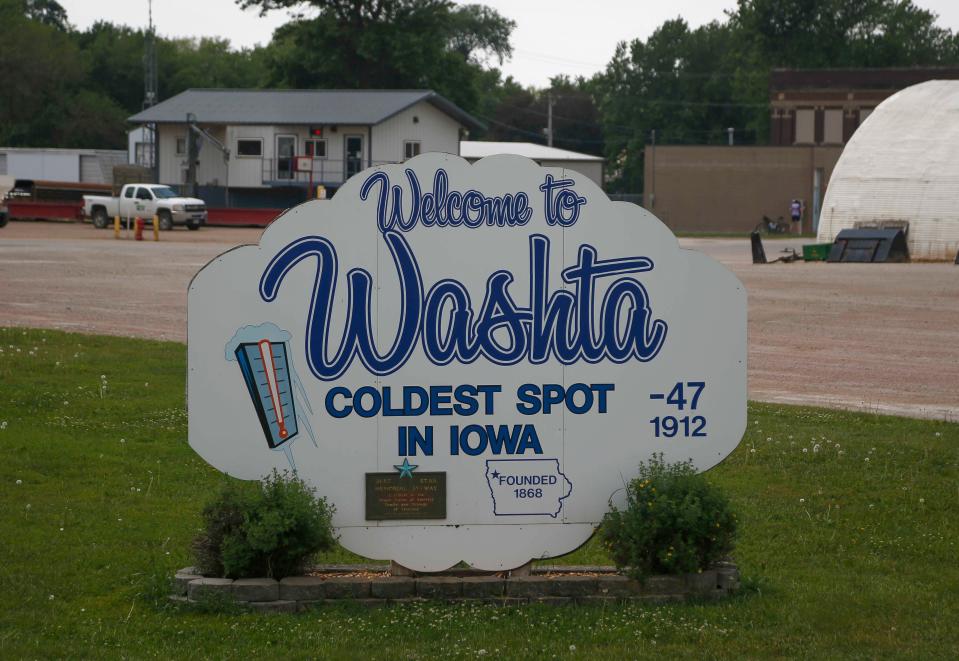
Day 1 meetup town Washta is planning a chilly welcome for RAGBRAI's 50th anniversary ride.
The Cherokee County town of barely more than 200 has a peculiar claim to fame: It registered a temperature of 47 degrees below zero on Jan. 12, 1912, the lowest on record in Iowa. So when the riders on the Register's Annual Great Bicycle Ride Across Iowa roll in, town RAGBRAI committee chair Jen Connor said Sunday, Washta will be ready with a dunk tank full of icy water.
It might seem a bit off-putting, but if July 23's weather is anything like it is for today's route inspection ride ― 89 degrees and intensely sunny ― the prospective dunkees will likely be hoping for on-target throws from the dunkers.
It's the first time in eight years that Washta, which was on the original 1973 route, will be hosting RAGBRAI. The ride then cut off registration at 12,000 to 15,000, but this year it has already registered 28,000, so Connor is urging everyone to prepare for a crowd at least twice the size of 2015's.
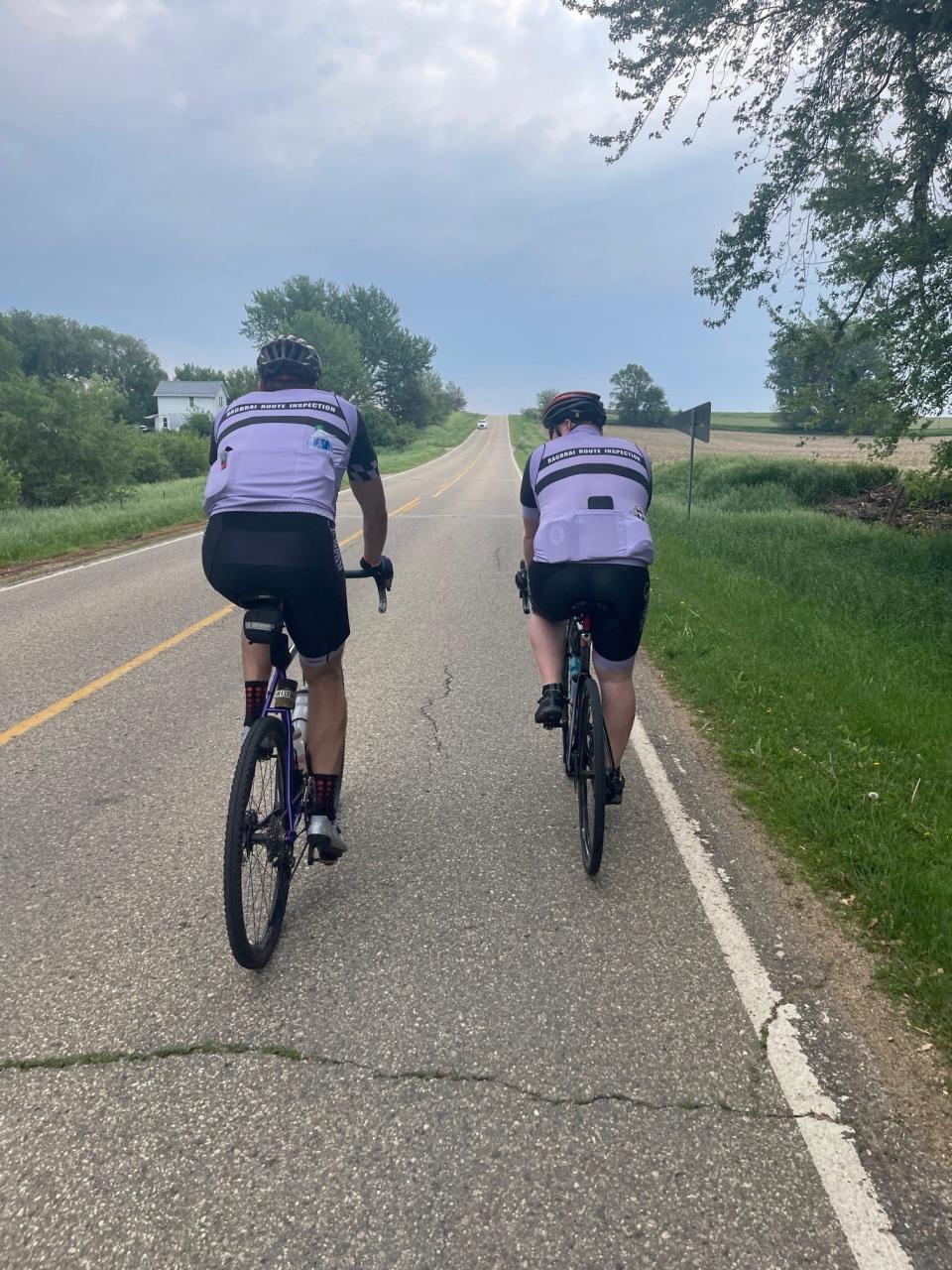
"We're trying to plan big because we know this is going to be huge," Connor said. "All the vendors know to prepare double what you're used to doing."
She's concerned, though, that they may no be picturing just how crowded it could get.
"I don't think they're putting into perspective doubling that number," she said.
― Philip Joens
11 a.m. Sunday
Day 1 this year could shatter records
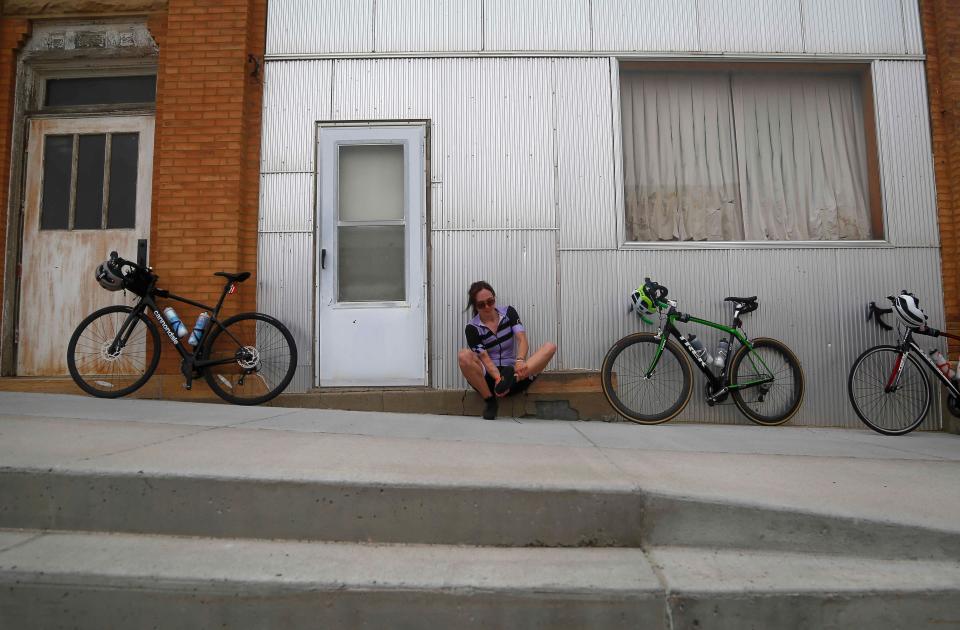
Just how big will the 50th anniversary RAGBRAI be?
Organizers of the Register's Annual Great Bicycle Ride Across Iowa offered some perspective as we made our way along the Day 1 route on Sunday.
Last year's RAGBRAI drew about 18,000 registered riders ― respectable attendance boosted by easier travel from out of state as the COVID-19 pandemic waned.
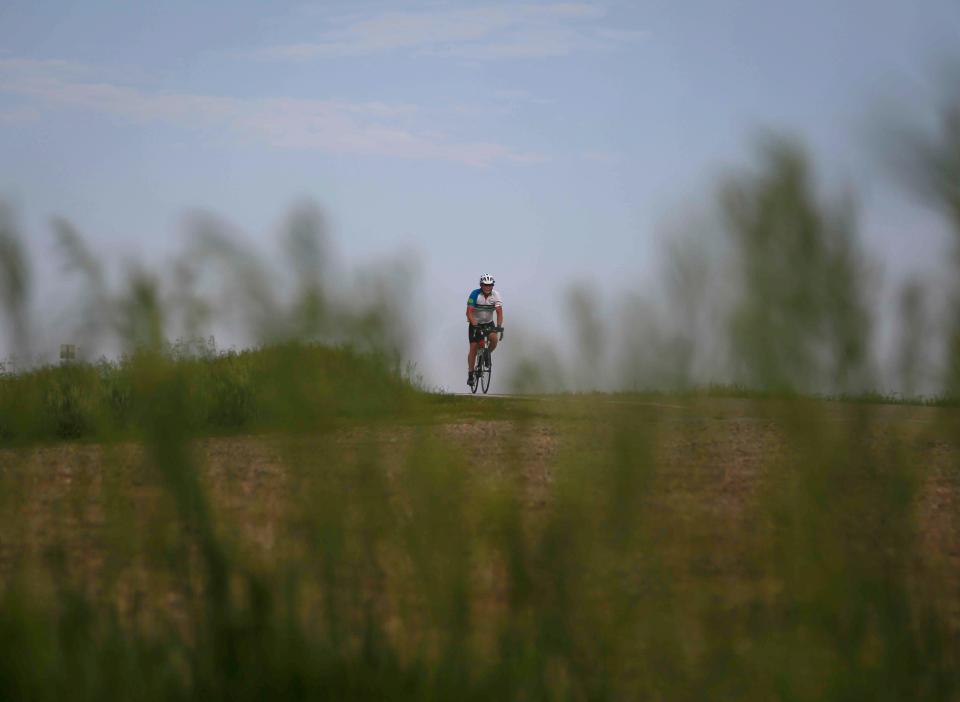
This year, there are 28,000, a 55% increase. And that's not counting the unregistered riders who boosted last year's Day 1 ridership to 30,000, the third-largest in RAGBRAI history.
A similar spike on Day 1 this year would push the total ridership north of a record-shattering 45,000. And that's before the Day 4 ride from Ames to Des Moines that's expected to be the largest in the ride's history.
The giant, rolling party ― with the line of riders stretching from horizon to horizon ― is one of the things that makes RAGBRAI special. But it feels like a privilege to be riding the route today with just the 40-member inspection crew.
― Philip Joens
10:15 a.m. Sunday
Day 1 route has its ups and downs
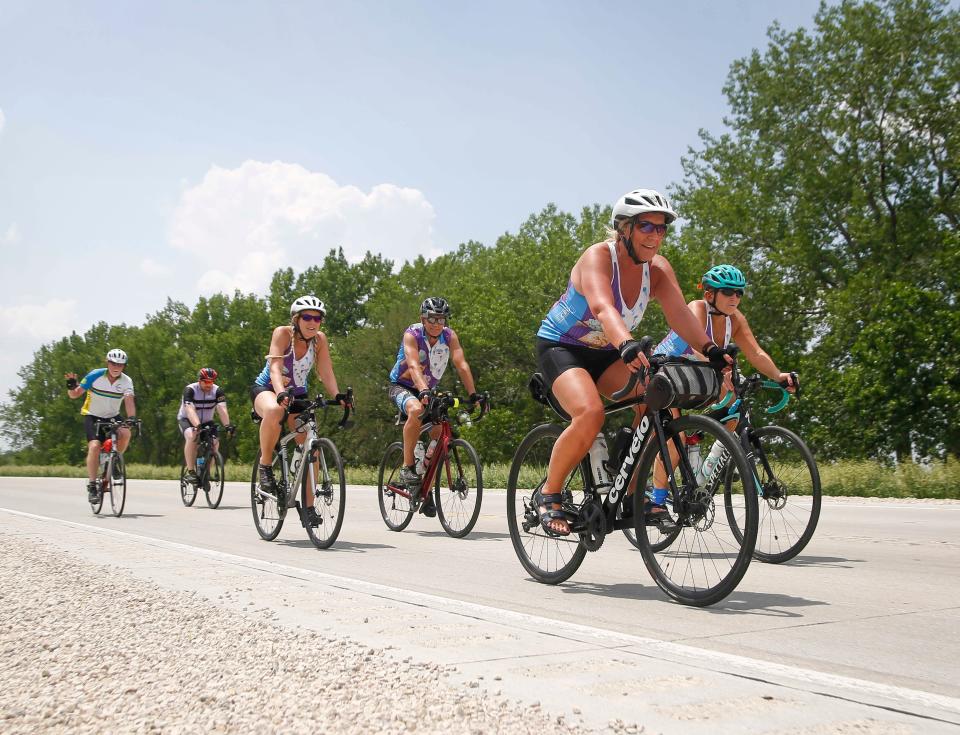
Ride director Matt Phippen wasn't exaggerating when he said the route for the 50th anniversary edition of RAGBRAI will be hilly.
It's always a hard pull climbing out of the Missouri River valley on Day 1 of the ride. But as we began the route inspection ride today, we encountered 13 of the day's 22 hills during the 29-mile segment that brought us to the pass-through town of Kingsley ― less than half the total 70-mile distance to overnight town Storm Lake. And with a bit of an easterly headwind, it got our hearts pumping.
It wasn't that Phippen was trying to torture us. The Day 1 route is the only one of this year's ride to duplicate the first day of the original ride in 1973, mapped by the two Register journalists, John Karras and Donald Kaul, who founded the event.
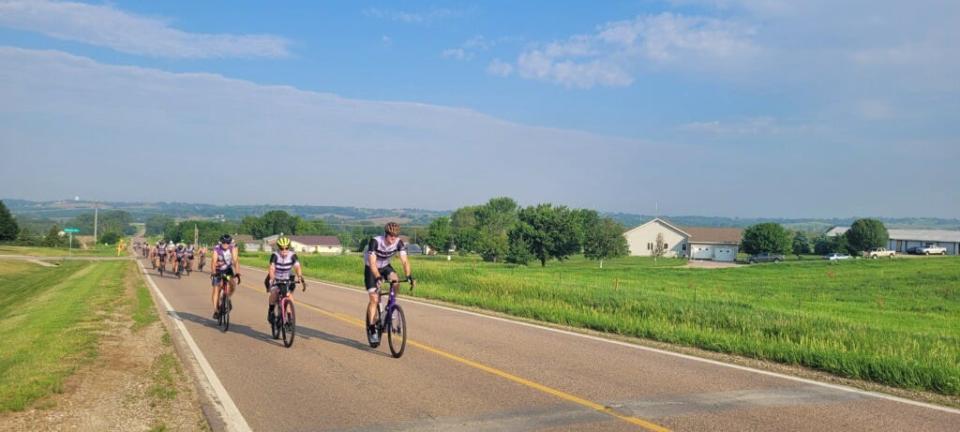
But there was something else that raised our pulse rates: the scenic beauty of the Loess Hills that march eastward from the river. Raised in Sioux City, I may be biased, but as a veteran of many Register's Annual Great Bicycle Rides Across Iowa, I've seen how the vistas of green pastures and corn and soybean fields cut into the hills affect the riders from around the world visiting Iowa for the first time.
And for those of us who've lived most of our lives here, it's a dramatic reminder of why Karras and Kaul wanted to make this ride in the first place.
9 a.m. Sunday
Mom's photos commemorate RAGBRAI history
It’s hard to imagine nowadays, but there once was a time when everybody didn’t have a phone with a built-in camera in their pocket.
That was the case in 1973, when a pair of Register journalists launched what would become the Register’s Annual Great Bicycle Ride Across Iowa.
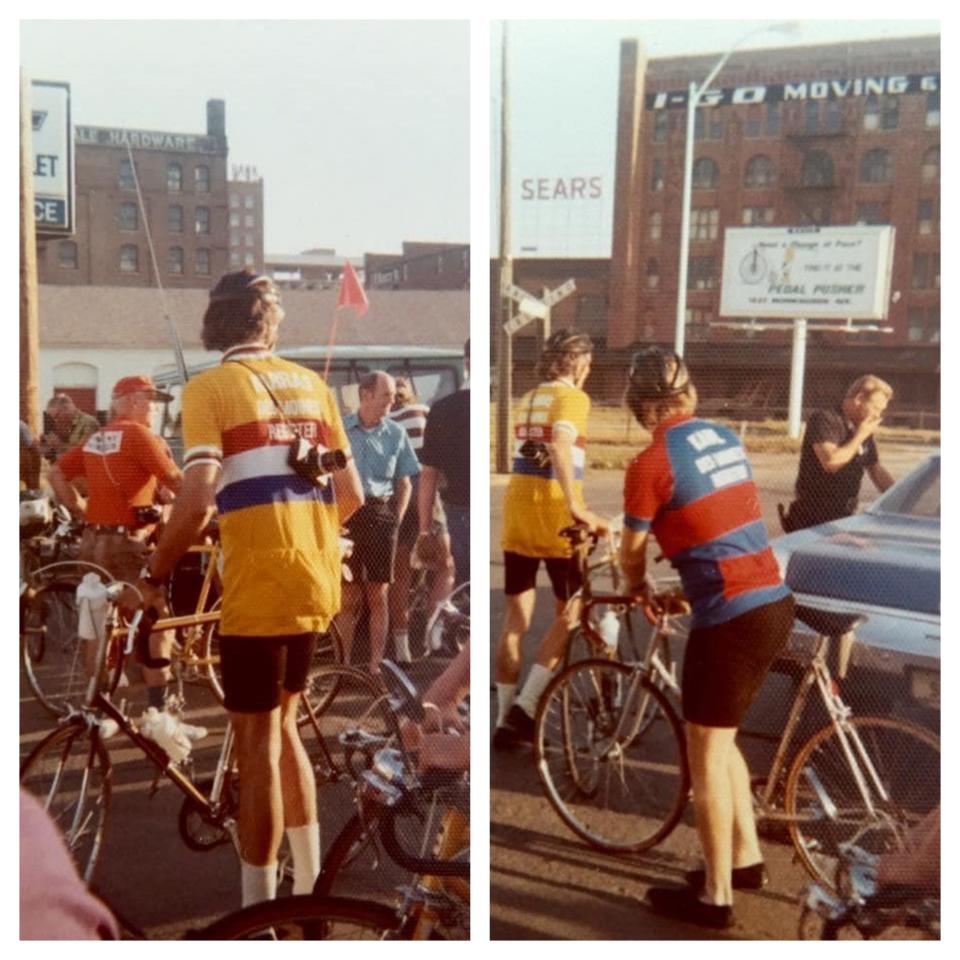
Photos of the start of that initial ride aren’t easy to come across, but there are a few, thanks to Kent Williams’ mother Shirley. Williams, now 65, was a 15-year-old from Eagle Grove when he participated in the initial day of what was then the Great Six Day Bicycle Ride with his father Roger, a school guidance counselor.
Williams said it was father’s idea.
“He said, ‘Let’s go on this bike ride’ because we had ridden bicycles together from Eagle Grove to Minneapolis to visit his brother and go to a Twins baseball game and we had ridden bicycles to eastern Iowa," he said.
He remembers it was a beautiful, blue-sky day, if a bit hot (the temperature would hit 99 degrees) as he and his father joined the roughly 200 riders who showed up to accompany Register journalists John Karras and Donald Kaul.
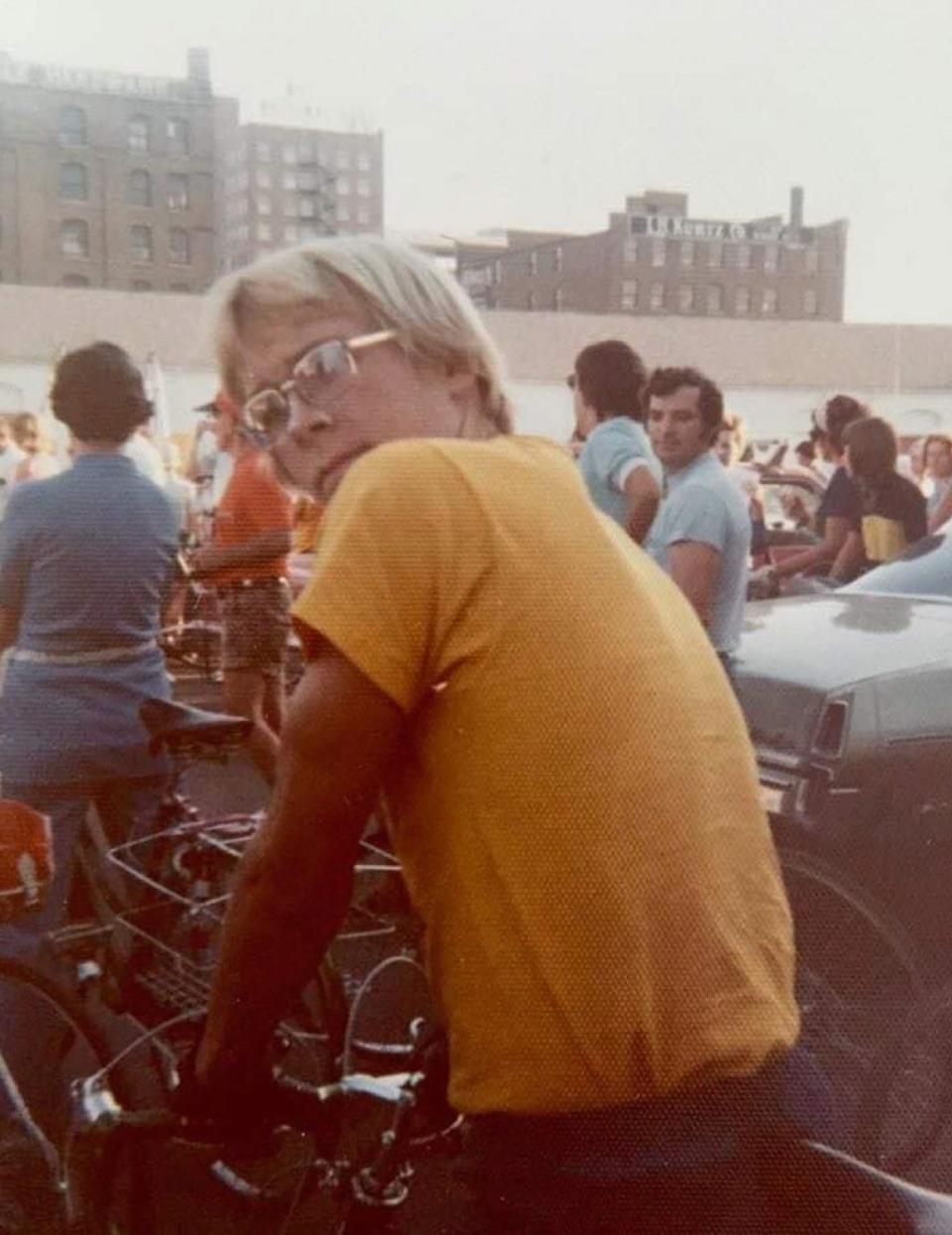
“I was so excited. It was an early moment of greatness to be able to be sitting on a bicycle next to Karras and Kaul,” said Williams, who was a Des Moines Register paperboy at the time. “They were larger-than-life heroes when you could read their stuff in the paper.”
Williams’ mother, now 88, photographed the founding duo and Williams and his dad as they took off from the Rodeway Inn where Karras and Kaul had spent the previous night. Sioux City RAGBRAI organizers used Williams’ photos to pinpoint the location.
“People did come and stand around and look to see what was going on,” Shirley Williams recalled, but no one seemed to realize they were witnessing history. “I think they just thought ‘There’s a bunch of crazy people going on a bike ride.’”
More: Varsity Cinema hosts premiere of 'Shift: The RAGBRAI Documentary' for sold-out crowd
Kent Williams rode the Second Annual Great Bicycle Ride Across Iowa in 1974 with his father and a friend. But he never rode RAGBRAI again after that. He had a long career in Army, could never get a week off work and settled in Oklahoma. But his father, with his mother as support driver, rode RAGBRAI through 1981. He died in 1992.
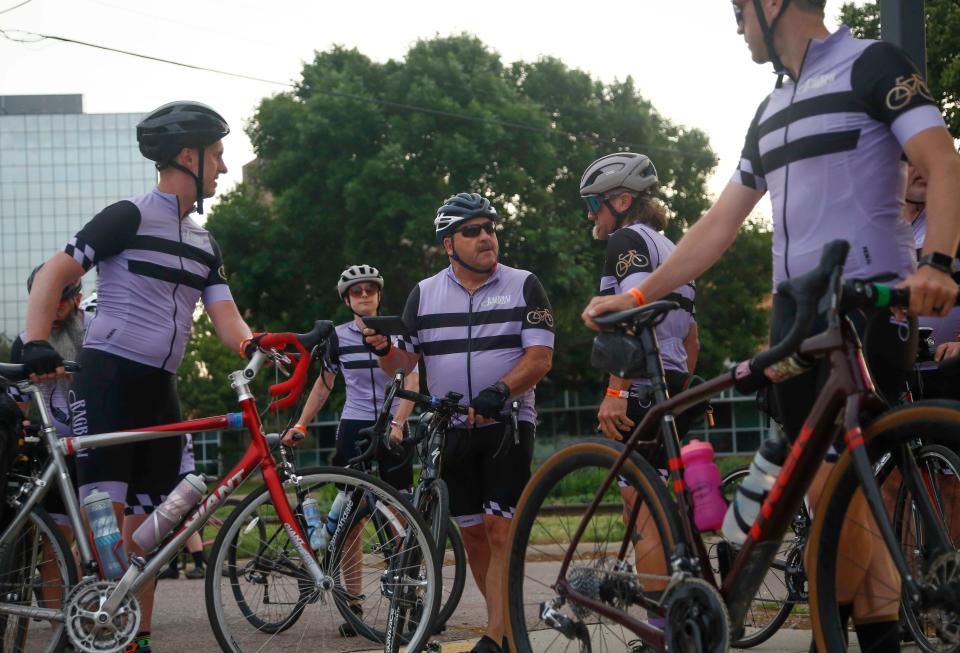
“It’s become something that I miss,” Williams said. “To me, the people that ride on it are legends.”
On June 3, despite having a total knee replacement not long before, Williams decided to ride the first day of RAGBRAI this year. He’ll reminisce and think about his Dad as he makes the nostalgic journey.
“It’d be cool to say I’m one of the few people who rode the first and 50th RAGBRAI,” Williams said.
― Philip Joens
8 a.m. Sunday
Suess-inspired sculpture will mark site of original ride's start
The 50th anniversary RAGBRAI inspection ride is underway. We're starting from Sioux City, where the city plans to mark the starting point of the initial ride with a bike sculpture inspired by the Dr. Seuss classic “The Cat in the Hat.”

As historic sites go, the former Rodeway Inn at Second and Nebraska streets in Sioux City where Register journalists John Karras and Donald Kaul had spent the night before starting what was then the Great Six-Day Bicycle Ride on Aug. 26, 1973, is a bit on the sad side. The hotel is now dilapidated and under renovation.
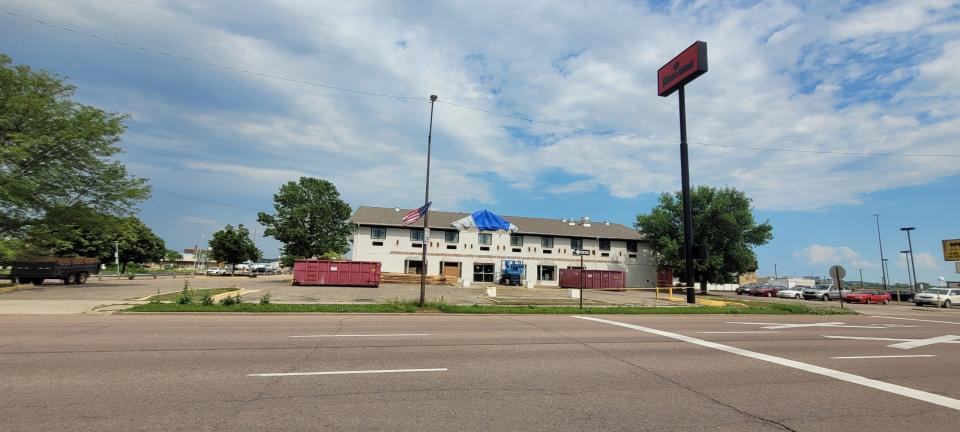
But it was outside the old motel at Second and Nebraska streets that more than 200 riders joined them ― Register readers responding to an impromptu invite to participate in a ride Karras and Kaul had envisioned as one they would go on alone. It planted the seed that grew into the Register's Annual Great Bicycle Ride Across Iowa, now the world's largest annual weeklong bicycle tour.
Since the motel doesn't look like much these days and it's private property, the city will install the sculpture across the street on the lawn of the Sioux City Art Center.
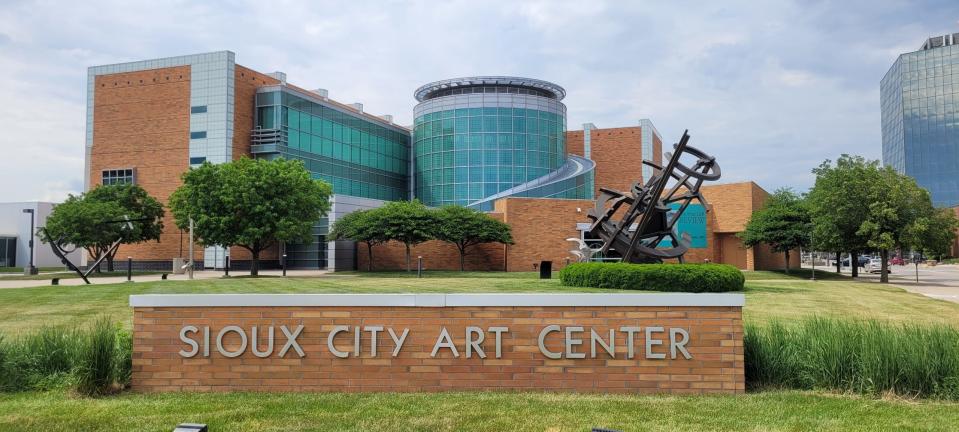
John Byrnes, Sioux City Parks and Recreation superintendent, said Sioux City wants the sculpture to be as fun and welcoming as RAGBRAI. Crafted by a local welding shop, it's a 25-foot-long “amorphous” tandem bike, like something out of a Seuss drawing, that people can pose on for photos, Byrnes said.
“It’s not this individualistic ride, what makes it fun is other people,” Byrnes said. “It’s going to be this absurd sculpture that you won’t be able to stay away from.”
When RAGBRAI is over the sculpture will be moved to a permanent place on a bike trail. Byrnes said it will serve as a continual reminder of RAGBRAI.
― Philip Joens
6 a.m. Sunday
RAGBRAI 50th anniversary inspection ride starts, and we're along for the journey
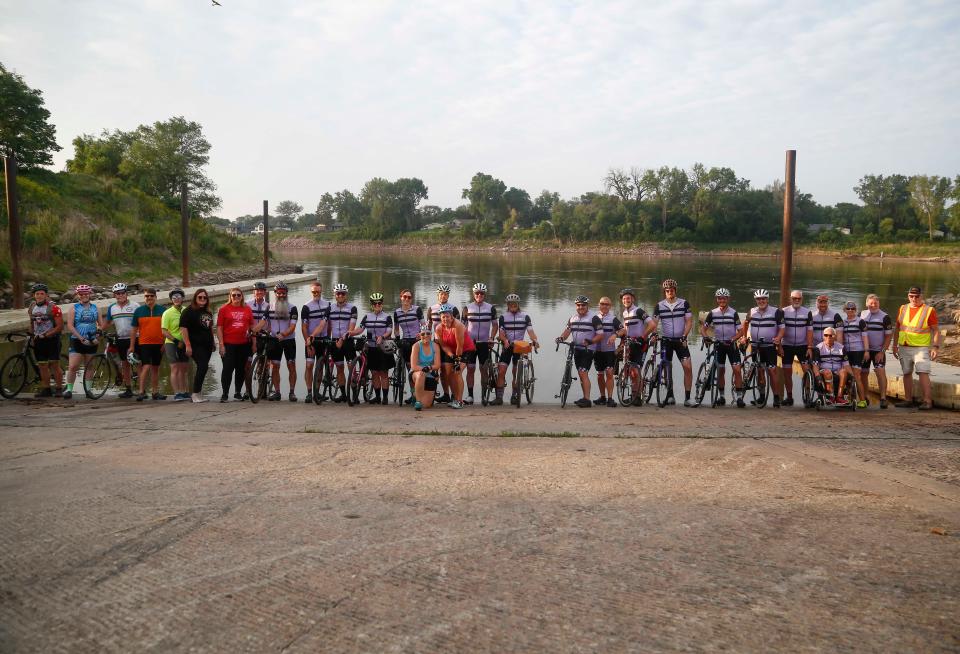
Welcome to our live coverage of the RAGBRAI 50th anniversary inspection ride.
When Des Moines Register journalists John Karras and Donald Kaul set out on their Great Six-Day Bicycle Ride in 1973, they and the roughly 200 riders who joined them dealt with obstacles like closed bridges, blocked roads and rutted pavement as they came to them.
But as the ride evolved into what is now the Register’s Annual Bicycle Ride Across Iowa, with thousands of people biking a seven-day route, professionalism took hold. Now, the ride has a dedicated, year-round staff that makes an inspection ride each June, weeks before the actual July RAGBRAI. It’s when they and invited guests can scrutinize the roads on which they’ll travel and make changes to the route or seek improvements where needed.
As RAGBRAI prepares for its 50th anniversary edition July 23-29, that ride begins today. Register, Ames Tribune and Iowa City Press-Citizen reporters and photographers will come along to document the route and provide a glimpse of what to expect on the historic ride.
Today’s route
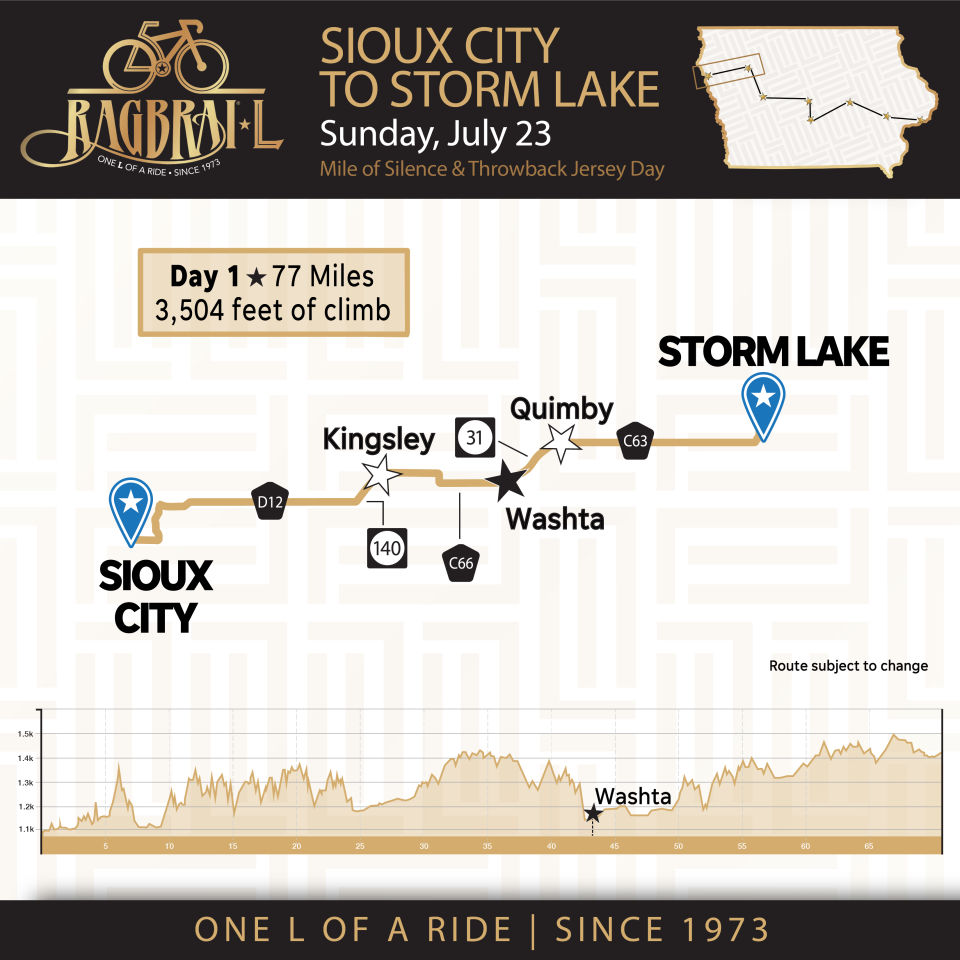
Sioux City to Storm Lake, just as on the first ride, in places following the original route.
Miles: 77
Climb: 3,504 feet
Meeting town: Washta
Pass-through towns: Kingsley and Quimby
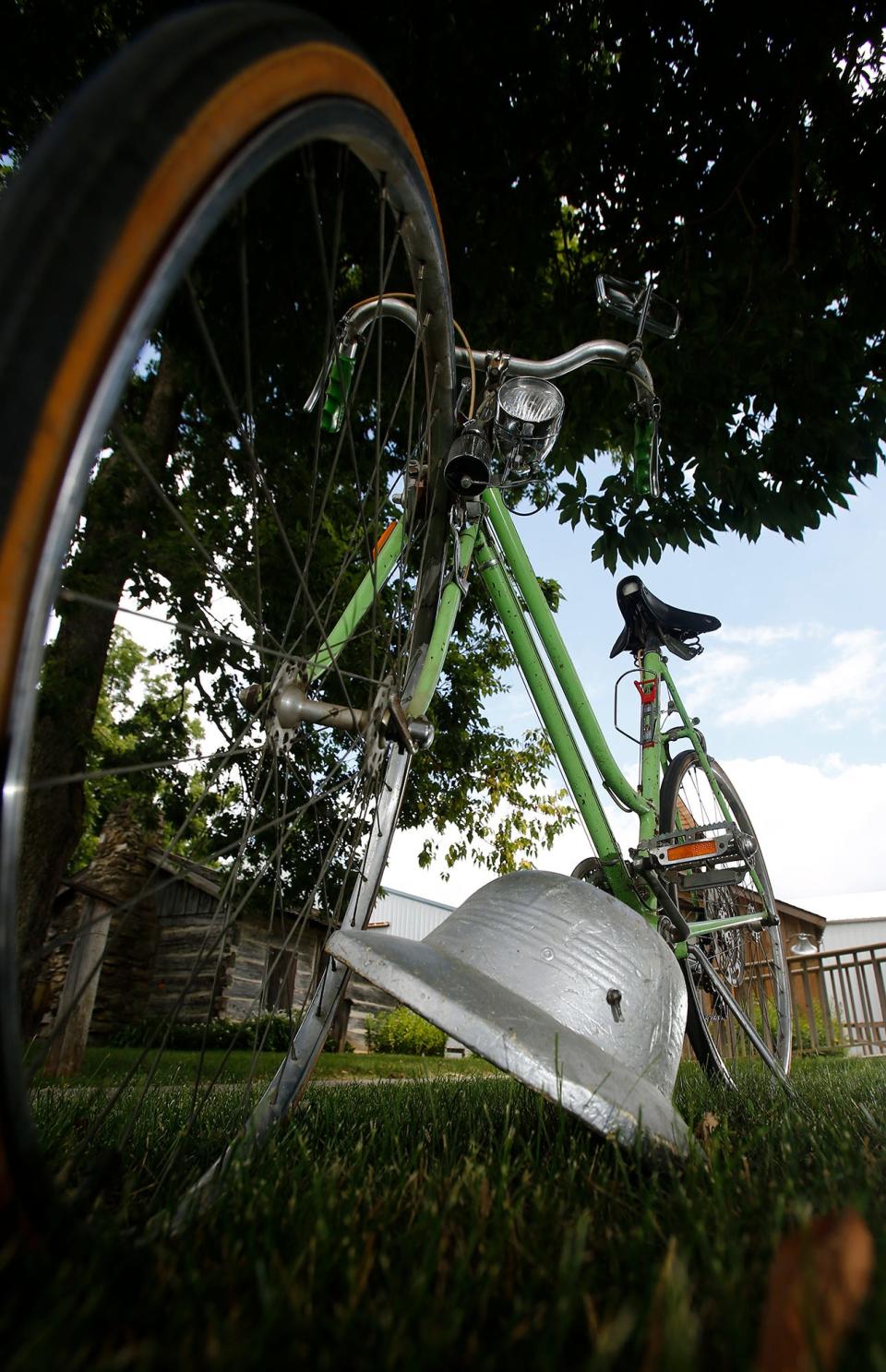
What to know: In 1973, this leg full of steep hills on a 99-degree day winnowed the entourage, but launched the legend of Clarence Pickard, a retired 83-year-old Indianola farmer who persevered for the entire ride on a second-hand women’s bicycle he bought the day before it began. And the town of Kingsley, one of this-year’s pass through, drew special praise in Karras’ coverage of the ride, becoming the first in a long line of towns to display vaunted Iowa hospitality by providing the riders with food and drinks courtesy of its business community.
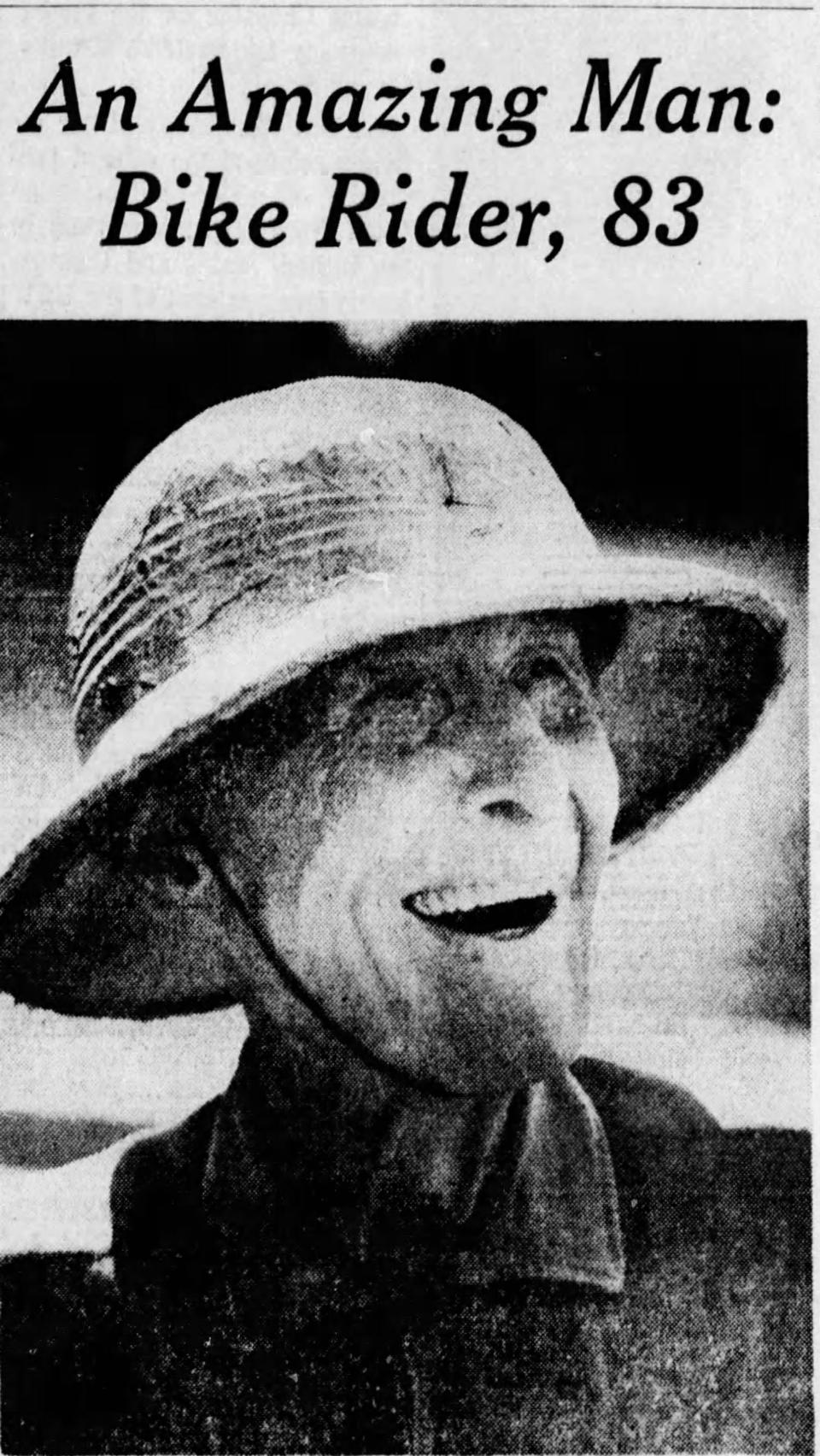
More to come: Keep checking back throughout the day, and this week's ride, for news of our adventure.
This article originally appeared on Des Moines Register: Live coverage: RAGBRAI's 50th anniversary inspection ride

